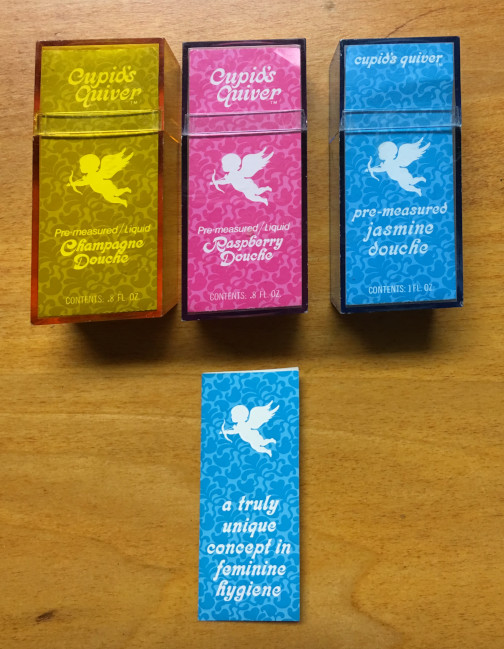

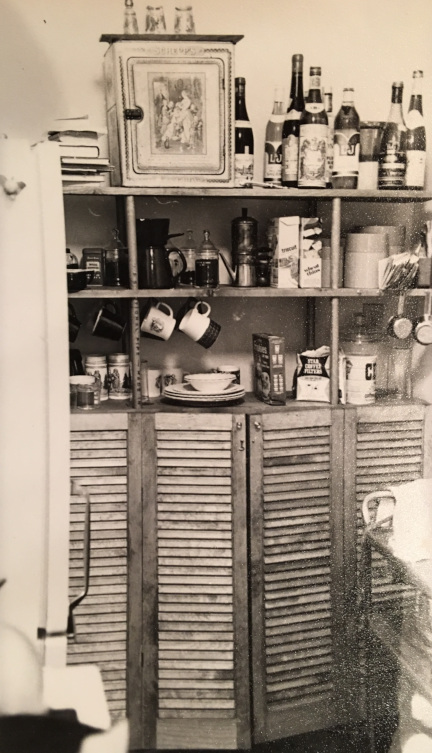
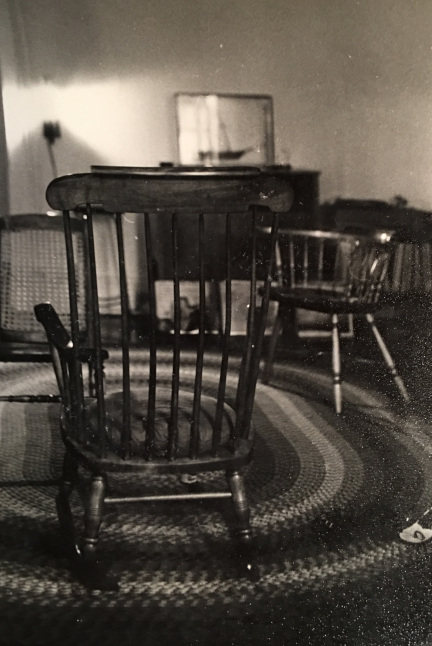
Ellen and Gene had lived in Philadelphia from 1965 until June of 1968. It was a momentous time in the city. Our first car was a 1947 Willys CJ2, which we soon traded up for a 1963 Toyota Land Cruiser. Since we occasionally traveled back and forth to visit relatives in the Harrisburg area, the larger and more powerful Toyota was a welcome change. On one of our trips back to West Philadelphia where we lived, as we traveled down the Schuylkill Expressway on a Sunday late afternoon, we could see massive columns of smoke arising from the blocks of burning buildings in North Philadelphia after the riots there.
Philadelphia at the time was just beginning to become an interesting place to live. The University of Pennsylvania and Drexel Institute of Technology, now Drexel University, were beginning to expand by demolishing blocks of townhomes in the area increasing pressure on surrounding neighborhoods, Society Hill had been "restored" and was an expensive enclave surrounded by slums and decaying industrial areas, lacking in the services needed in a residential area, and the South Street Renaissance was a few years in the future. It was a town with many great sandwich shops, a great symphony orchestra (the Ormandy years), and lots of potential. But there were few places outside of the universites that were "fun" for young people. And few really good restaurants accessible to the masses. So a move to New Orleans seemed promising.
Gene got a job in New Orleans at the U.S.Public Health Hospital, aka "The Marine Hospital", located in uptown New Orleans. We drove there in our Land Cruiser, which we fitted out with storage and a sleeping bunk in the back. We drove throught the Great Smokey Mountains and camped with the bears, then down through the deep south. On the way, we heard of the murder of Bobby Kennedy, and drove through towns in that part of the country that we knew of from the beatings and deaths of civil rights advocates. It set a gloomy mood, and when we stayed in Slidell overnight before driving into the city, we were treated to the brown colored rotten egg smelling "sulfur water" there and kept awake by the sound of flying night creatures being electrocuted by the industrial strength bug "zapper" outside our window.
When we finally got to New Orleans, we found it green and lovely and the water there quite ordinary. In short order we rented an apartment near the hospital, on St. Charles Avenue, in the very most uptown part of the Avenue, near "riverbend" and about 4 blocks from the end of St. Charles, where the streetcars turn onto Carrollton Avenue toward the lake. The river was a short distance away. The house itself was a Victorian era home of massive proportions, with a large "belvedere". It was set well back from the Avenue, with a huge magnolia tree in the front yard. The house had an interesting history. It was owned by a family named Carruthers, two sisters who lived on the first floor, and they had converted the upper floor to a rental, which is where we lived. The home was massive. The rooms on the second floor had 14 foot high ceilings, and those on the first floor were higher. There was a large porch across the front, accessible via the tall windows opening out onto the porch and extending down to the floor. The belvedere could be reached by a stairway accessible through our apartment, and one of our jobs was to check the attic for leaks when there was a storm.
The oral history of the owners was that the house had been the plantation home for the original plantation that became the town of "Carrollton", which had been platted out in the 1830s and existed as an independent town, part of Jefferson Parish, until annexed by New Orleans in 1874. The plantation had been the Macarty Plantation, part of the original Bienville land grant of 1719. Whether or not the house we lived in had been the Macarty home, I do not know, nor have I been able to find any information about that, but in the course my life, I have been more and more impressed by the veracity of oral history, so I am inclined to believe it. One Carruthers relative claimed that as a young lad, he could still see a line of tall oaks extending to the nearby river marking the original approach to the house.
If it was not a plantation house, the home was for a time known to be a party house. Owned for some years before the Carruthers bought it by a wealthy Houston "oil man", it was his second home, where he kept his mistress, and when he and colleagues came to New Orleans by train, they would party at the house with the mistress and other female guests invited by the mistress. There is no history about how and when and why the oilman gave up the house. But it was unoccupied for a time until bought by the Carruthers. We leased the upstairs apartment for two years, at which time we bought a house nearby. When we moved out, the Carruthers newly married daughter moved in with her husband. After that, we lost track of the family, and sometime around Katrina flood, the house was purchased by a local businessperson who divided into many student apartments and paved the front yard for parking. The house appears to be sinking into gentle decay again and awaits the next owner to restore it and perhaps find out its full history.




The neighborhood was remarkable to young people moving from west Philadelphia. A couple of blocks away, a commercial district on Maple Street had a grocery store (The Belmont) a hardware store (Meniere Brothers} as well as clothing stores, a gas station and auto repair shop, and a really good traditional French restaurant (Etienne's), as well as bars and more casual dining places. Since Tulane and Loyola were nearby, about ten blocks away, there were some students living in the neighborhood as well as faculty and staff, but not so many students as to make it unpleasant. There was a bookstore nearby, the Maple Street Bookstore, successor to Tess Cragor's earlier Basement Book Shop, and a curious place, The Sun Shop, which sold Native American artifacts, beads, and beading supplies. More about the Sun Shop and Chick Fortner later.
The neighborhood was named Carrollton after the town which had originally been a separate city, in Jefferson Parish,laid out in 1833, incorporated in 1845, and annexed by New Orleans in 1874 (becoming the city's 16th and 17th Wards). It had originally been the land of the McArty Plantation in Jefferson Parish, the upriver border of the city of New Orleans.
The area we lived in corresponds to the present day city planning commission definition of "East Carrollton", bounded by St. Charles Avenue, Carrollton Avenue, Spruce Street, and Lowerline Street.
The annexation of Carrollton by New Orleans created an anomaly in New Orleans street names; Lowerline Street is upriver from Upperline Street, which was originally the upriver boundary of New Orleans before the city annexed another suburb in the 1850s.
The neighborhood and Avenue are pronounced "kaa-rull-ton" or "kaa-ril-tin" by residents and other uptowners, but many people from the downtown parts of New Orleans (especially those born in the mid-20th century and earlier) pronounce the names as "Karl-ton".
Tulane University and Loyola University New Orleans are just a few blocks below Carrollton, and many students, faculty, and staff live in the area and patronize the businesses there.
In addition to Carrollton Avenue and Saint Charles Avenue, the neighborhood still retains two "neighborhood main streets" of mixed residential and commercial use. Lower Carrollton centers on Maple Street, with many restaurants, coffee houses, bars, and upscale shops. Upper Carrollton has Oak Street, formerly hosting somewhat larger businesses (such as Woolworth); current businesses there range from restaurants and a hardware store to the best known of the neighborhood's live music venues, the Maple Leaf Bar.
The historically predominantly African-American neighborhood adjacent to Carrollton lying along the riverfront has been known since the mid-20th century as "Black Pearl." Mahalia Jackson, the "Queen of Gospel music", was from the Black Pearl.
In sum, our first home in New Orleans had the best any city could offer. Most everything we needed was a short walk away. The people in the neighborhood were friendly and we quickly felt at home there. For additional shopping, there was even a big Winn-Dixie several blocks in one direction and a Katz and Besthoff (K&B) drug store a few the other way. The street car stopped close to our house on St. Charles. Ellen commuted to her job at Loyola on the streetcar and we frequently rode it downtown to the French Quarter to go to Preservation Hall.
Soon after our arrival in New Orleans, a classmate of mine, traveling through on the way to a job in Houston, stopped in for a few days. He and I had played in an informal jazz group, made of students and faculty, which played on weekends just for fun. Jack loved traditonal New Orleans music, what is now known as "Trad Jazz". During his visit he and his wife, Ellen and I, went to Preservation Hall where he introduced himself to Al Jaffe, the owner/manager. Mr. Jaffe was very kind and generous with his time, spending hours with us in the hall and in the rooms behind it, explaining about what the mission of the Hall was and telling stories about the still-living musical legends that played there. Subsequently we spent many evenings at Preservation Hall. We were most definitely hooked on New Orleans music.
Here are some Preservation Hall photos of some of our favorite musicians: Big Jim Robinson (1892-1976) trombone; Percy Humphrey (1905-1995) trumpet; Willie Humphrey (1900-1994) clarinet; Cie Frazier (1904-1985) drums. In addition to these musical legends, we also heard Emma "The Bell Girl" Barrett (1897-1983), George Lewis (1900-1968), Kid Thomas Valentine (1897-1987) and many others, all now gone.

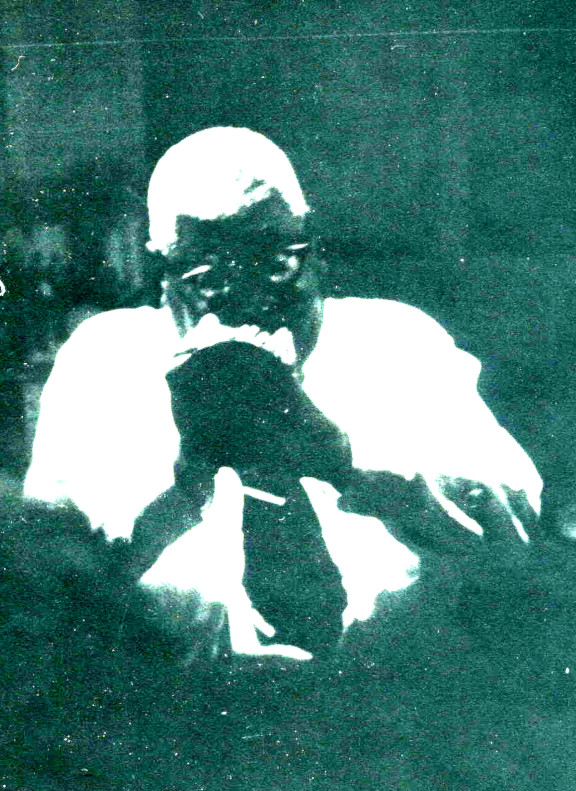
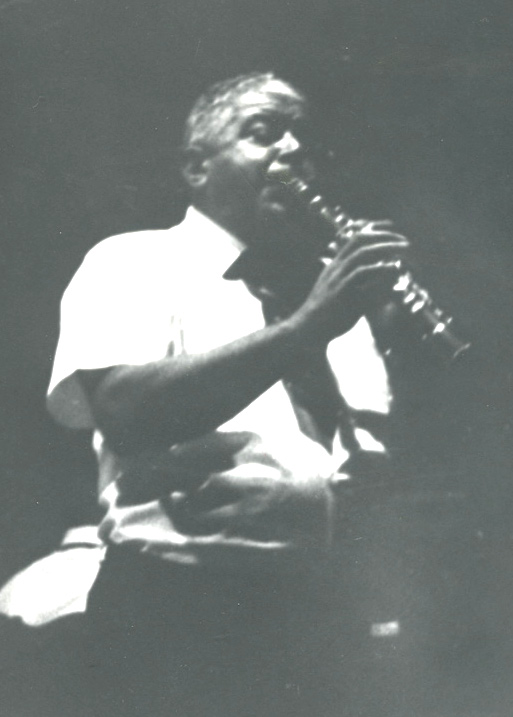

Years later, on a visit to New Orleans in 1994, we took our youngest son to see Percy Humphrey and his band at Palm Court. I spoke briefly with Percy, offering condolences on the recent death of his brother, Willie. I told him that Ellen and I had listened to the two of them play in the sixties at Preservation Hall and we had brought our son to hear him. Percy was gracious as usual, seemed delighted to meet a new generation of fan, and was still playing well at 89 years of age.
New Orleans is a friendly town and through friends at work, we met many neighbors and our circle of friends grew. Many friends lived within a few blocks. Two of our closest friends were Thorny and Liz Penfield, who lived on Burdette Street, just around the corner from our place. Thorny shared our interest in traditional music, and one day, I belive sometime in late 1968 or 1969, he asked if I might be interested in attending a "jazz funeral". Something I had never heard of. A prominent musician had died and a traditional funeral procession was planned. I don't recall whether the funeral was for George Lewis or Alcide Pavageau, but it was a big procession. We were not permitted in the church, but joined the procession, now it would be called a "second line" and walked with it along Claiborne Avenue to the cemetery, and later through the neighborhood (Treme) as the crowd got smaller with each bar we passed. The event was truly life-changing, and provided context for so much of the music I had been listening to ever since. Through Thorny I met Michael P. Smith, a photographer who spent his career documenting many aspects of African American cultural life in New Orleans, from the churches and church music to the Mardi Gras Indians and everything in between. Mike died in 2008, but donated his collection of photographs to the Historic New Orleans Collection where they can be accessed today.
Here are some of the photos I took at the funeral. It was many years later that I learned about the unfortunate history of Claiborne Avenue and the decades of unrelenting attempts to destroy the Treme neighborhood. But that is a topic for later.
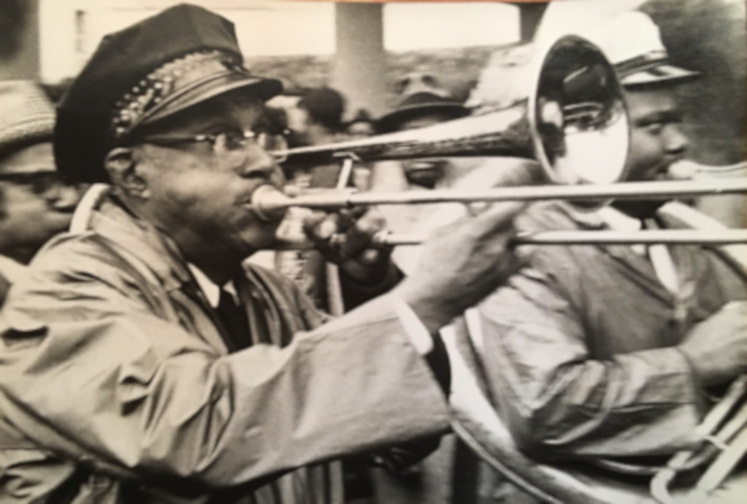
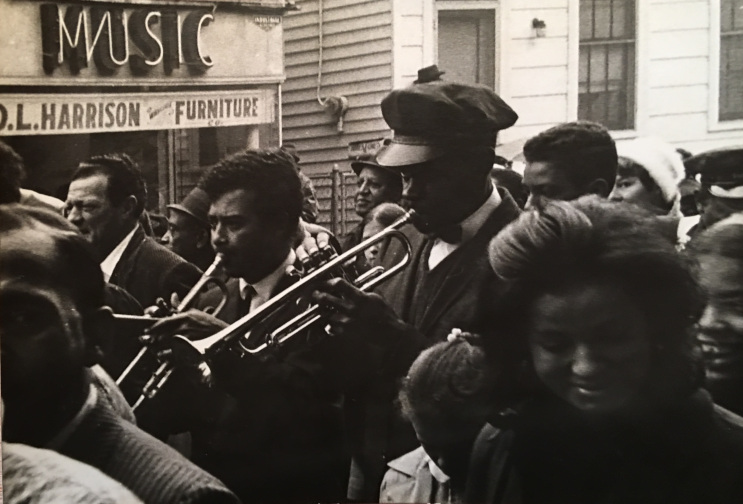
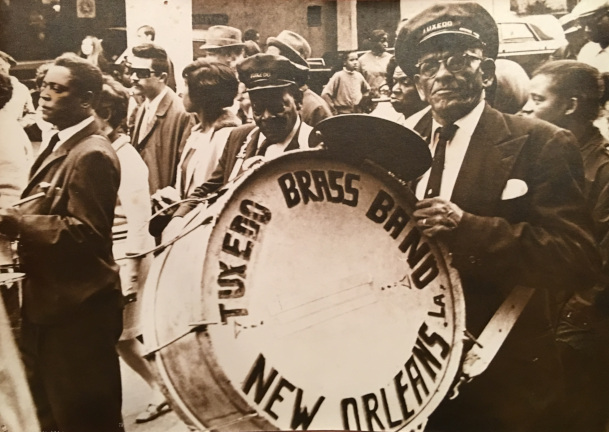
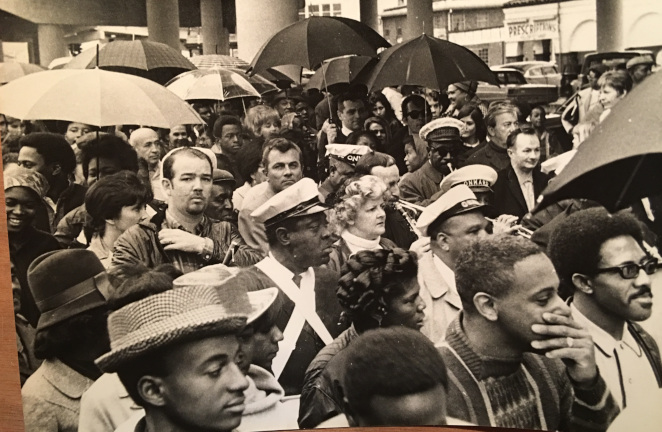
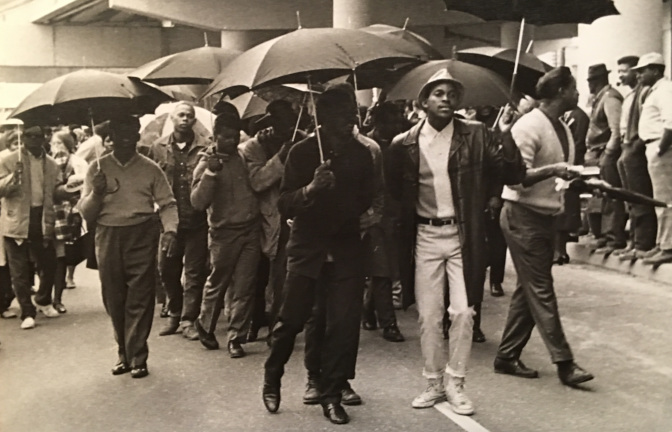

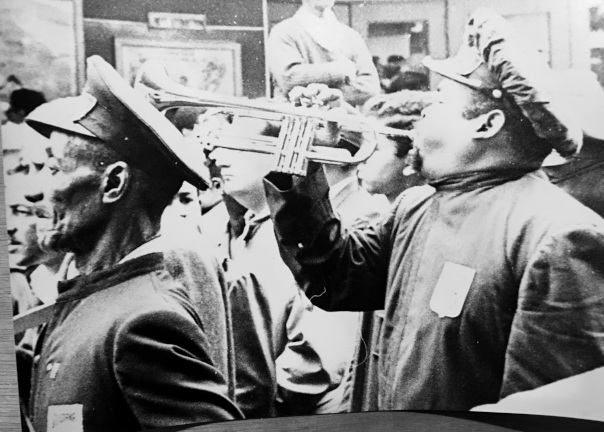
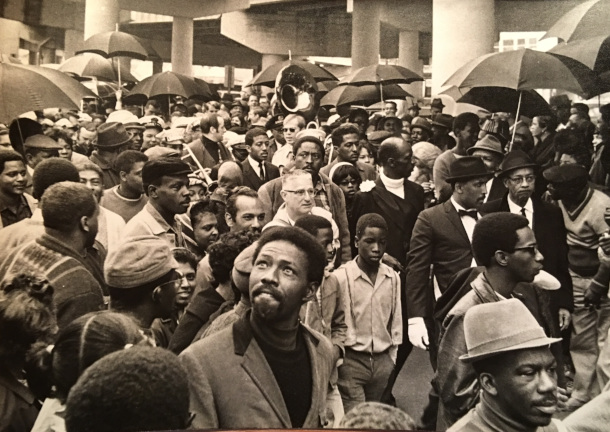

The funeral procession was an impressive experience and there was plenty of ritual and custom and culture on display. The crowd was largely African American, but everyone was welcome, the only requirement was to be respectful. I still remember the bands playing slow hymns as the procession walked quietly toward the cemetery. "Just a Closer Walk with Thee" still gives me chills. And "I'll Fly Away". As the bands walked along, they would play a drum rhythm so everyone could keep in step. Then, with a ruffle, they would begin a slow song. At the beginning of each hymn or dirge, well dressed men, sometimes in small groups, would remove their hats and with a snap, bring them in front of them as they began a slow, hesitating, step in time to the music. Here are a couple pictures of these gentlemen mourners

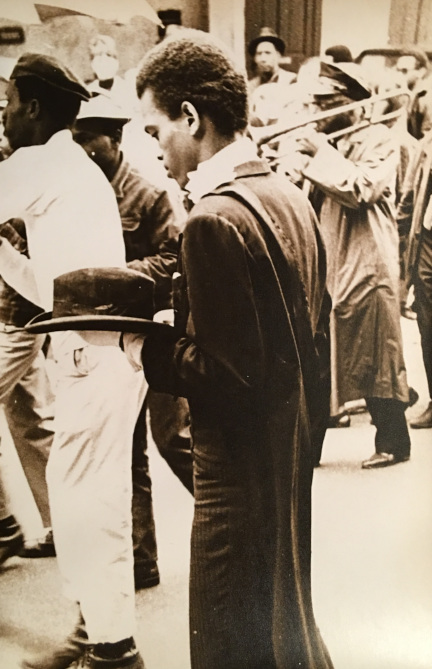
Overall, the processional was respectful. Many mourners carried umbrellas, as shown in the pictures. Not the gaily decorated umbrellas/parasols often seen today, but ordinary workaday black umbrellas.
As the crowd approached the cemetery, which one I do not recall, the hearse had already entered the grounds. Suddenly, a trumpet call sounded, followed by a shout from the crowd, then another call, another shout, and the bands erupted into joyous music, accompanied by frenetic dancing by the mourners. A truly magical scene. And then, the entire ensemble started to dance through the neighbohood, wending its way from bar to bar as the crowd diminished with each stop, until the final remaining band found a home at a final bar, played a bit, and the crowd was gone.
In today's New Orleans, so-called "Second Lines" are common. These are more street parades than funeral processions, but they do also happen on special events, such as a wedding or a funeral. Most, however, are planned events, sponsored by one of the many "Social Aid and Pleasure Clubs" (SAPC) or other marching groups. And it is even fairly common to see a wedding second line wandering through the French Quarter, where it is possible to book a second line through various agents, probably through a hotel concierge. But the neighborhood clubs still put on the best shows. Sundays are the usual day for these events, and in an average year, 40 out of 52 Sundays will have a second line somewhere in the city. They only take the summer off, and start up again in September. See Baby Dolls, Marching Clubs and Social Aid and Pleasure Clubs for more about second lines. There is also more information about Mardi Gras Indians and other parading organizations you can find links to more information and pictures about parading organizations of New Orleans on the New Orleans Again Page.
While I was working at Charity Hospital in about 1970, I was chatting with a colleague, Eddie Casanave, and we discovered a common intrest in beads. We were using beads in our Macrame, and he was using beads to make his Indian suit. I knew nothing about Mardi Gras Indians, but he was kind enough to bring in a small sample of what he was working on, beading onto cotton fabric, a sort of cotton duck. I marveled at how difficult it must have been to sew the beads onto that heavy cloth. I told him about the "Sun Shop" near our house and its bead supply and invited him to come take a look. He did, but did not find any beads he could use, as he was pretty much restricted to using "seed beads" and was not interested in fancier beads, even though the shop stocked a wide range of beads used by Native Americans for their dance costumes. Now, of course, the New Orleans Indians use every imaginable sort of bead, gemstone, sequin and feather in the suits. I regret not learning more about Eddie's beadwork or ever seeing his complete suit, but as I recall the design he was working on, I think he must have been in and "uptown" gang. I never saw any Indians in the streets during our first stay in New Orleans. At that time, their parades were pretty much furtive and restricted to certain neighborhoods and they were severely hasseled and beaten by the police when they were unlucky enough to be found. Today, it is much different, and the Indians have emerged from the shadows and are a valued part of the culture and community. See here for more information about and contemporary photos of Mardi Gras Indians of New Orleans.
Our life in New Orleans included an introduction to good food. Having grown up in the Pennsylvania German cooking traditions we found the typical New Orleans restaurant food quite exotic. And with Etienne's Restaurant a block away, we ate out a great deal. Eating out, we found, is a recognized avocation/hobby in New Orleans, and people followed the changing locations of favorite cooks/chefs like others follow baseball or football player trades. With the fresh seafood of the gulf, the produce of semi-tropical farms and gardens, the African cooking traditions, and the long history of eclectic cuisine with French, Spanish, Native American, and Italian, influences, dining out was (and is) an adventure. Another life-long interest.
During our time in Pennsylvania, before moving to New Orleans, we had developed intrests in craft activities. Gene had built ship models and model airplanes for years and wanted to learn woodworking and furniture making, and Ellen who played harp was becoming interested in weaving and other fiber arts. We had started to accumulate some of the tools we needed for these pursuits, and not long after moving to New Orleans, a friend, Leah Feinstein, a sculptor, who had rented a small shotgun house to use as a studio asked if we wanted to share the space (and the rent). The house was about six blocks from our apartment and was formerly one of the typical little neighborhood stores found throughout the city. In this case, there was a small three room shotgun, perhaps 800 square feet, with a small storefront added to it. The store part had a concrete floor and was about 15 x 25 feet in size. Initially, our friend used the front, and Ellen and I set up in the other three rooms of the house, but in a short time, our friend found a better studio and we had the place to ourselves. With a monthly rent of fifty dollars.
Soon our days consisted of eating a fast dinner after work and heading to the studio for several hours of craft work. Ellen set up a loom there, and I had a small wood shop. It was there I made a shaker style desk of African Mahogany, which we still have. I had fallen in love with the African Mahogany wooden rails and seats of our friend's Ensign (see below) and found an excellent source, Dixie Lumber, for rift-sawed mahogany, both Honduran and African. I stocked up on both, and we carried the lumber on all of our moves, using the last of it when in Santa Fe, about 45 years later. It was well seasoned wood.
Some pictures of our "studio".

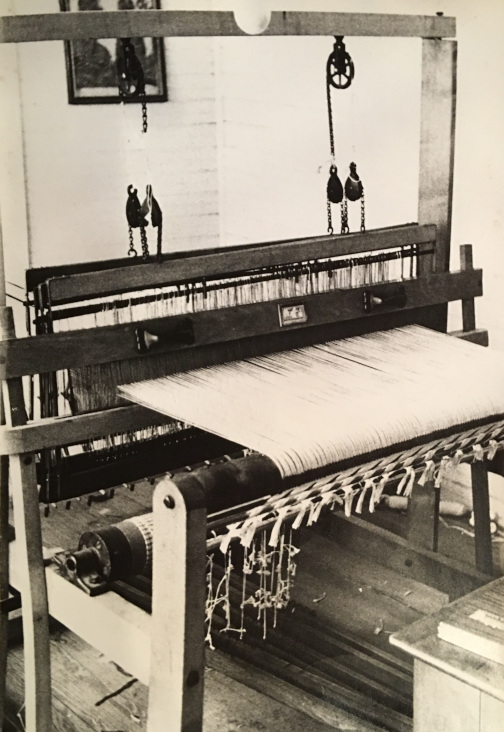
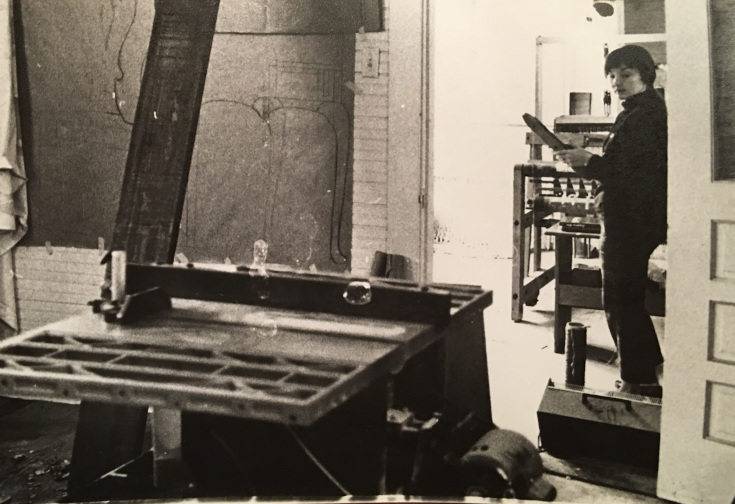
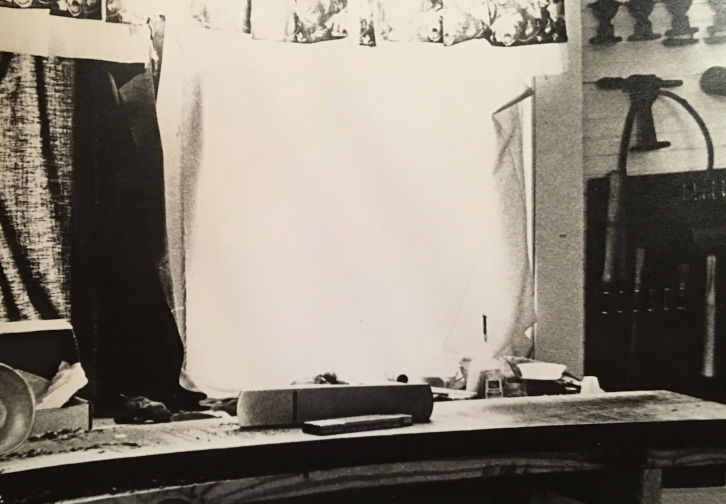
Somehow, with all this happening, during our first year in New Orleans, we also started sailing on Lake Pontchartrain with friends, Thorny and Liz Penfield, and others. And when the Penfields decided to sell their sailboat to buy a larger boat with a proper cabin, we bought their Ensign, hull #337. Two of our other close friends, Artie and Merce Silverman, had Ensign #338, so it was just another part of our growing family. Ensign #338 was later destroyed by a large storm surge during hurricane Camille driving her up onto the concrete breakwater lining the shore of the lake. A sad end. We later sold #337 to Simone Stern of Gallerie Simone Stern when we traded the sail boat in for a house.
Atie and Merce lived on Fern Steet, the next street uptown from Burdette, and we got to know them and their three children, Jim, Linda, and John. Artie was a surgeon at Touro and working part time at sculpture. He became quite good, developed his own minimalistic style, and perfected the difficult processes involved in fabricating aluminum for sculpture. Afte he retired he worked harder than ever at his sculpture. He did mainly public art and his pieces can be found throughout New Orleans and much of the southern United States.
In another example of things coming in circles, when we moved into our "retirement community" on the west bank of New Orleans (Algiers), one of the first things we noticed was a sculpture by Artie in the central courtyard.
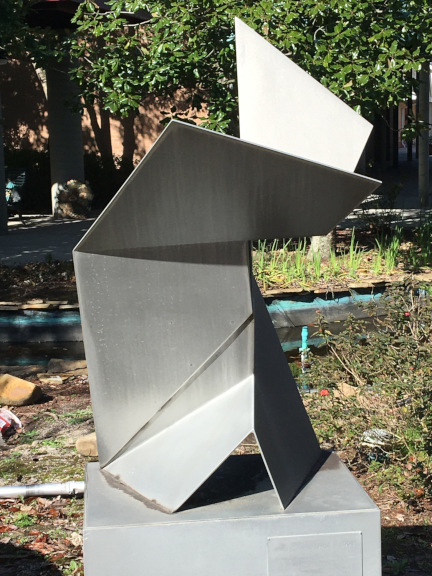
Here are some pictures of sailing on the Lake with various friends.
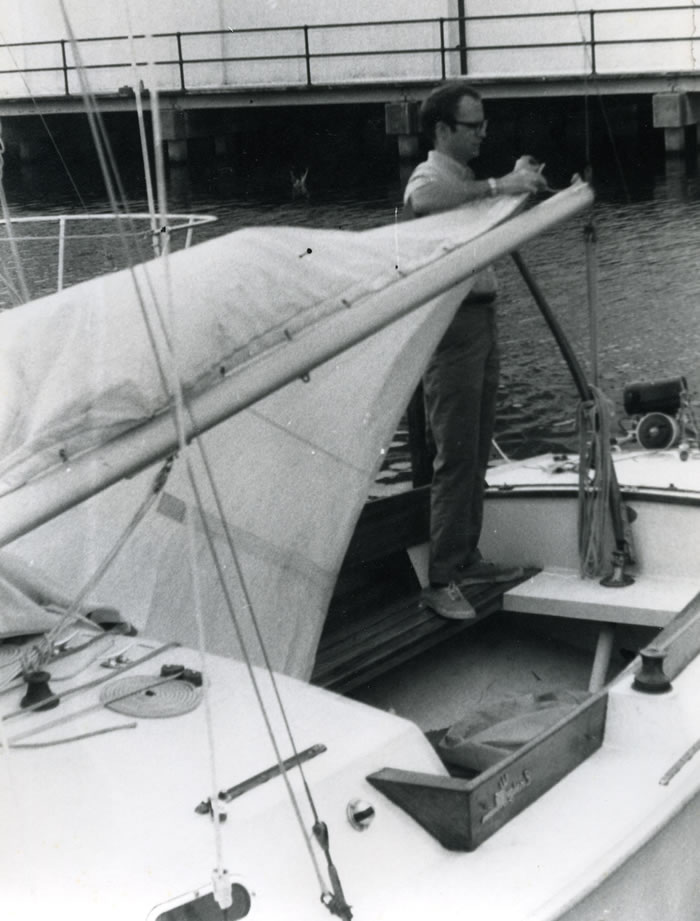
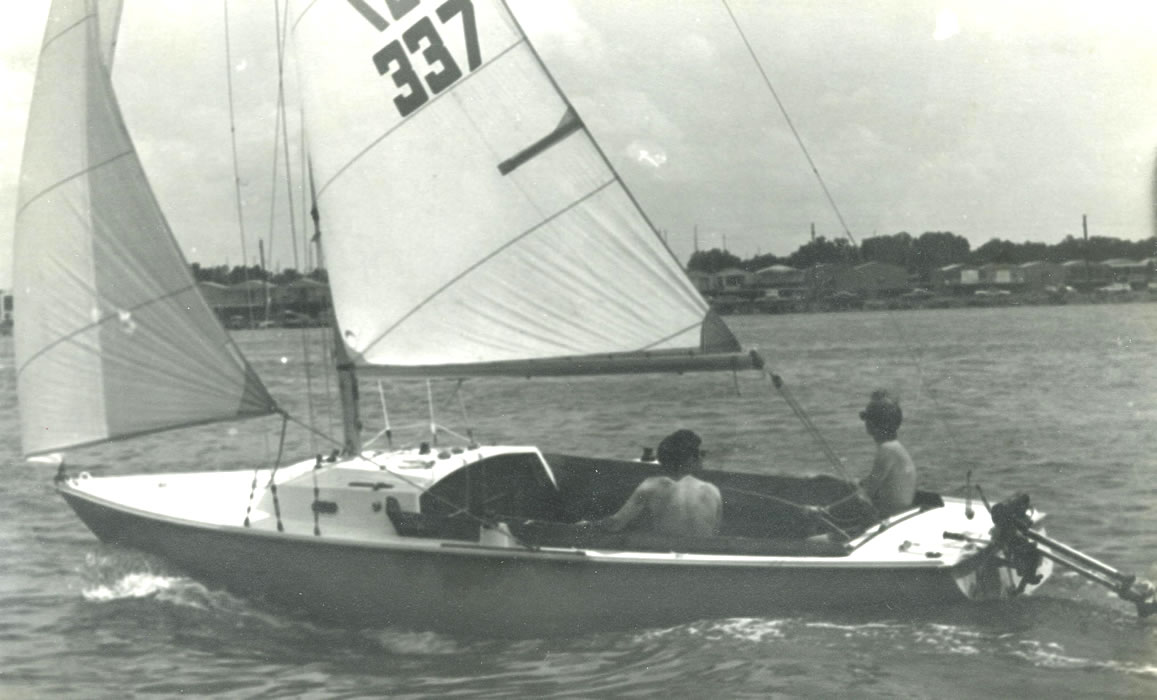

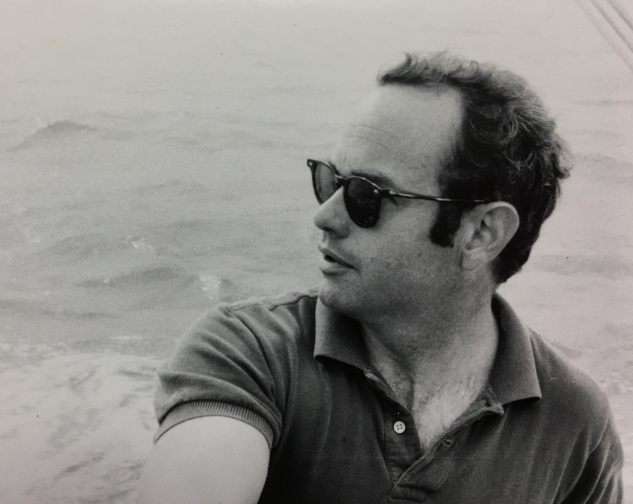
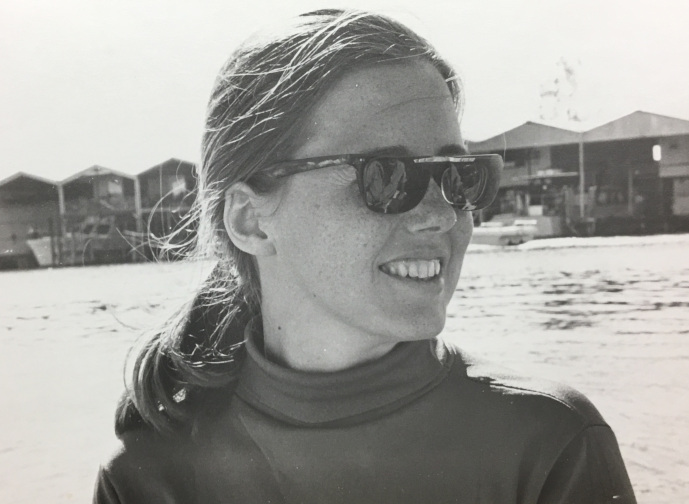
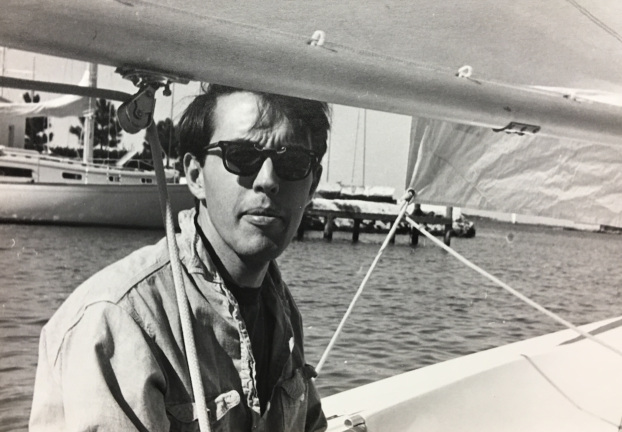

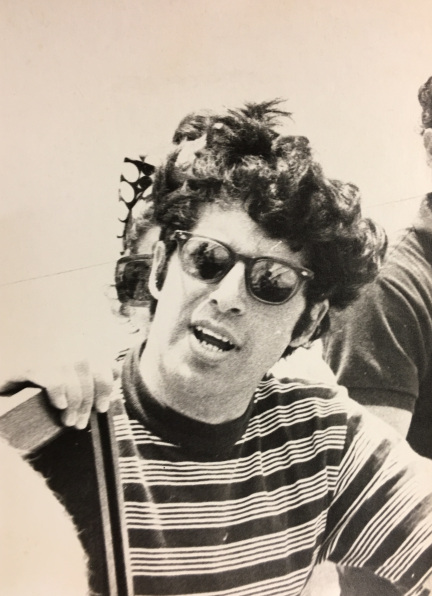
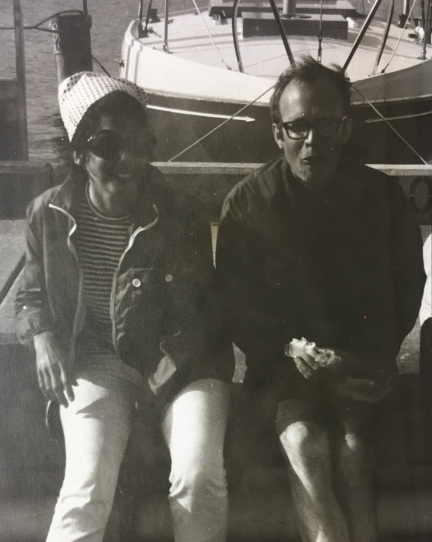
As we got more serious about out craft activities, around the time our two year lease on the St. Charles Avenue apartment was to end, the house next to the Penfield's home on Burdette Street came on the market. We sold the sailboat to help with the dowmpayment and bought the house, our first home purchase, for about $23,000. It was a sweet, classic, side-gallery shotgun house, with white clapboards and black shutters. It probably originally fronted on Maple Street, but a past owner had enclosed the front porch and moved the entrance to the side, on Burdette Street. 729 Burdette to be exact. The house was about 1,000 square feet,and had original hard pine floors, two fireplaces with coal grates and was perfect for the two of us. It also had cypress wood shutters and clapboards, so despite some years of neglect, the wood had not rotted and looked great with a simple coat of paint.
The house, and the one next door owned by the Penfields were "board houses", the two of them built in the early 1800s from the same river barge. In the days before steam power, cargo from the upper midwest was shipped downriver in barges made from hard yellow pine in Ohio and other midwestern states, and when the barges arrived in New Orleans, there was no way to return them up river, so they were broken up and the lumber used to build homes in the growing city. The construction method was to build a floor platform, then set up the boards vertically to form the walls, tying them together with cross beams/joists and then adding the roof. That meant that the walls of our house were solid hard yellow pine about 2 1/2 inches thick. The pine was covered on the outside with cypress clapboards (and cypress shutters) and on the inside with a layer of cheesecloth over which wall paper was applied directly. All this I found out when I tried to drill a hole into a (non-existant) stud space to run a wire. In conversations with native New Orleanians, I found out that this construction technique was fairly common for a time, and many two and three story residences, even "mansions" were built this way. Which may explain why there were so many exposed pipes and wiring conduit on the sides of older homes in the city. From time to time, in older neighborhoods, you still see the solid wood walls of these board homes exposed during remodeling/gentrification.
The house worked out well for us, and I installed a small darkroom in the utility shed in the back yard, where I processed most of the photos on this page.
When we left New Orleans in mid 1971, we sold the house and for a time it was an office for a lawyer, as I recall. It survived many storms, including Katrina and the subsequent flooding, but through the years it lost its shutters, chimneys, back yard, and most of its interior charm as successive commercial uses altered the floor plan and uses of the building. It is currently an Asian fusion restaurant. Here is a picture of the house in the mid 1980s, in 2012, and picture of what it looks like in 2019.
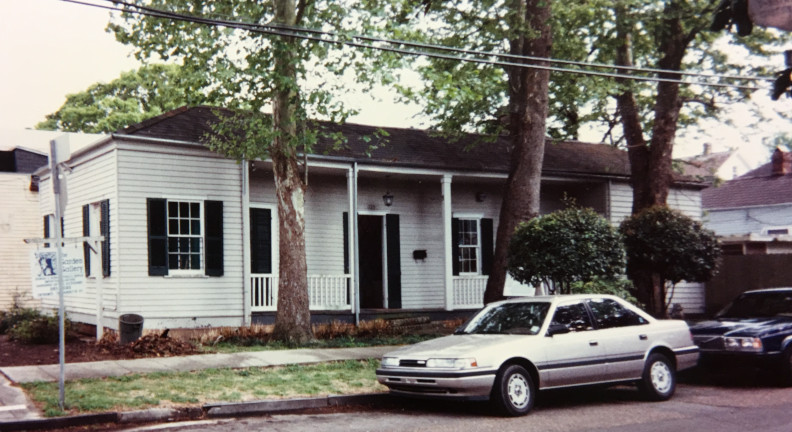
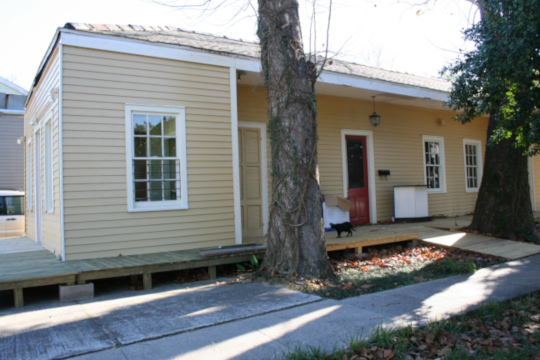
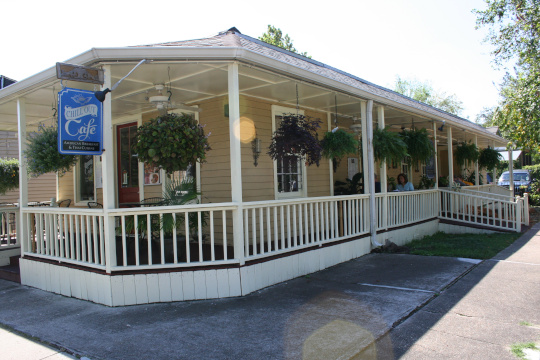
In the meantime, we had also acquired a dog, "Dixie", a rescue if there ever was one. Dixie had been found by Chick Fortner, when he came to visit our studio and heard a puppy whining in a vacant house next door. There were three small empty shotgun houses and Chick surmised that some neighborhood kids had locked the dog in one, perhaps intending to return to harm the dog or burn down the houses. Anyway, he rescued the dog and we adopted it. She was a delight and lived with us for a number of years, moving to New Hampshire, where her short Beagle-looking coat grew out into a luxurious long coat and we realized she was a Border Collie. More on our New Hampshire adventure on that page.
We continued to be very active in our crafts, and even expanded our interests a bit when we began doing macrame. Another friend, Betty Wisdom, had invited us to her home to watch "The Forsyth Saga", a BBC program showing on PBS. We did not have a TV at the time. We needed some kind of hand work to do while watching the show: Betty did needlework, Ellen knitted, and I decided to take up macrame, since wood carving wasn't practical under the circumstances. We started doing it together using Virginia Harvey's book "Macrame, the Art of Creative Knotting" as a start. We quickly mastered the basics covered by the book and realized that the craft had much greater potential than anyone currently working has tapped. We began making elaborate three dimensional sculptural hangings and lamps as well as clothing. The Macrame bikini was a popular item. Gene made up a couple of samples and we took them around the corner to the Sun Shop, where the owner, Chick Fortner, was happy to hang one in the window and take orders. He also sold other items we made and ended up being a great supporter, even ordering vast quantities of the special cotton seine twine we used for our projects. As our designs progressed and became more popular, Chick also took a supply of finished items on a selling trip to New York City, where our wide, colorful belts were a popular accessory item used to brighten up the then current drab "midi dresses" that were briefly fashionable. We sensed there was a market for the newer style of knotting we were doing.
One of the customers for a bikini was a lady named Jacquiline Ward. She was originally from France and married to an American, Jim Ward, a local poet and photographer and erstwhile documentarian who had worked for a time at the NASA location where they manufactured the Saturn V rockets. NASA had a facility in New Orleans East, the Michoud Assembly Facility, which had been originally developed by Andrew Jackson Higgins during WW2 for the manufacture of tank engines and for other intended but unrealized purposes. Higgins is perhaps best known for the "Higgins boats", the landing craft used during amphibious attacks in WW2 and for the Higgins PT Boats. Higgins also manufactured many other things needed for the war effort and had expanded his operations to multiple sites employing thousands of people in the New Orleans area. After the war, his business declined and after his death in 1952 many of the facilities were sold off. The Michoud Facility was later acquired by NASA. NASA also had another facility in nearby Slidell, where rocket engines were tested and refined for use in large rockets, such as the Saturn Five.
Jim was an idealistic man, something of a "hippie", a writer hired by NASA to document the Saturn V program. Jim took the job, despite a deep distrust of the government, because he believed and hoped that the "space race" would be an peaceful alternative to war. After some time at the job, however, he realized that the program designing the "space" rockets was really only an Intercontinental Ballistic Missle Program writ large. On his final day there, while attending a management meeting (as documentarian, of course), he chose that occasion and forum to propose his solution to the vexing political problem of the then current (1968) American war on Vietnam. His proposal was simple: Stop bombing and shooting immediately, but leave all personnel and equipment in place to avoid the economic dislocation and unemployment likely to result from returning a quarter million service members to civilian life abruptly. (see Report from Iron Mountain ) Instead, begin immediately dropping consumer goods onto the entire Vietnamese countryside - small items to start, but escalating to larger appliances, televisions, and so forth. The theory being that other cultures fought for/wanted all the consumer goods that Americans enjoy. And, the practical result of this "bombing" campaign would be two fold: first, the falling items would largely be destroyed on impact, keeping American factories busy making replacements, and, second, more Viet Cong would be killed by falling appliances than were currently being killed in combat operations. Once every house and humble hut in the country had a full set of appliances, the people would demand electric service to operate them, and the Vietnamese government would have to hire American contractors to install the electric grid. In the meantime, the bombing would switch from appliances to automobiles with the same expected results except that the people would demand roads. And the government would have to turn to US contractors to create a national highway system, at which point the local populace would begin to kill themselves in auto accidents at an even higher rate, and the American economy would have expanded to accomomdate the return and re-integration of former service members.
Jim's proposal to the NASA management team was met with silence, and he left the meeting, cleaned out his office, and left the facility for good. When we met him, he was free-lanching a bit and planning a move to France, to the rural area where Jacqueline was from, having given up on America. As we talked with Jim and Jaq (never "Jackie") Jim suggested to us that we write an instructional book on the type of Macrame we did. He explained that a book was a better way to make money that making and selling product or teaching classes. He also explained how to put together a proposal for a book that could be submitted to several publishers without conflict or contractual problems. He did the photography for the proposal and helped with the editing. His, and Jacq's, pay for the work was Jacq's bikini.
Once we had some proposals ready, we mailed them off to several publishers with a cover letter saying we would be in New York in a few weeks and would contact them to find out their intrest. Confidence. We traveled to New York and called the publishers, including Van Nostrand Reinhold, the publisher of the Virginia Harvey book, by this time a best seller, for a craft book. Ellen made the call to VNR, and the publisher himself, Jean Koefoed, took her call. He told her that VNR alrady had "the definitive Macrame book". Ellen replied that we did not think so, and he agreed to meet with us. After the meeting, and review of our proposal and samples of the work we were doing, Mr. Koefoed agreed with us and we left with a book contract. We did not realize how lucky we were.
We returned home and started working on the book. Jim and Jacq Ward were leaving town, so we found another photographer, Lynn Franklin for the black and white photos and Larry Songy for the color. We even found a professional model, Geraldine Duskin, to model the clothing for the color illustrations. The whole experience was much fun and a learning experience, especially about the publishing industry of the time. See our Publications Page for more about the first and subsequent Macrame books as well as other books and pamphlets. The book was published to great success, and carried the day for VNR, putting it in the black that year (1971). By the time it was released, we had moved to New Hampshire and did several book publicity tours from there.
In the meantime, back in New Orleans, we had gotten to know our studio neighbor, Mike Price. Mike, and later his girlfriend Susan, lived and worked in the house across Birch street from our studio.
This is what Mike's studio/house looked like in 2012.
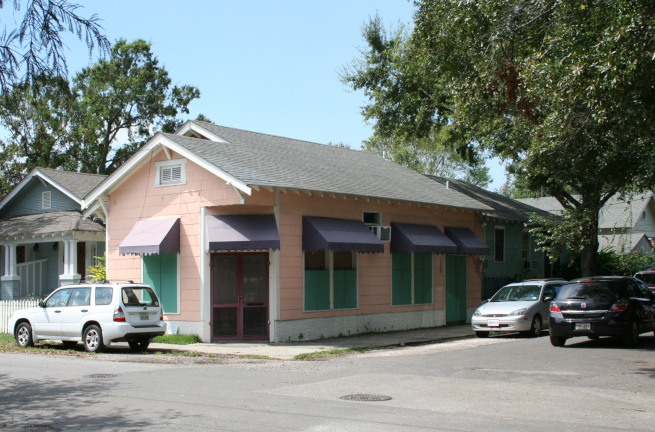
His place has also been a neighborhood store, in this case, a butcher shop, and he had set up his studio in the store and lived in the attached small shotgun. Probably we met because we kept the same late night hours and worked weekends, but in time the four of us became very close. Mike was a realistic figurative artist, who worked in bronze and was in his final year of an MFA program at Tulane-Newcombe. And nobody liked cole slaw more than Mike. And nobody could make such good cole slaw from just about any ingredients found late at night in the refrigerator as well as Mike.
In the early summer of 1971, Mike and Susan left New Orleans for St. Paul Minnesota, where Mike had taken a job in the art department at Hamline University. Mike continued to do his own work while teaching full time, and specialized in public art, often liturgical in nature. He has a renowned statue of F. Scott Fitzgerald displayed in St. Paul and other work at many locations, including in the sculpture garden at my alma mater, Ursinus College. After the move, Susan completed library school and went on to become a well known garden expert, author of multiple books on gardens and native plants of Minnesota. Mike died in 2001, but we still are in touch with Susan and see her everytime she is in town.
We had a chance to see Mike casting multiple pieces at Lin Emery's foundry in New Orleans. There are a couple of pictures from that session below.
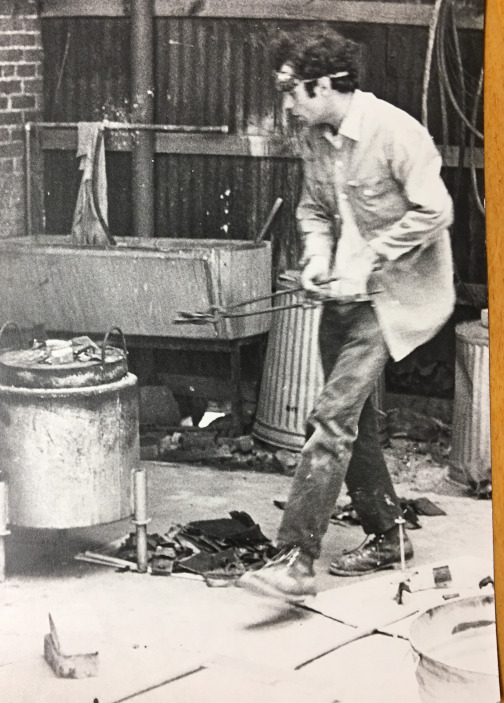
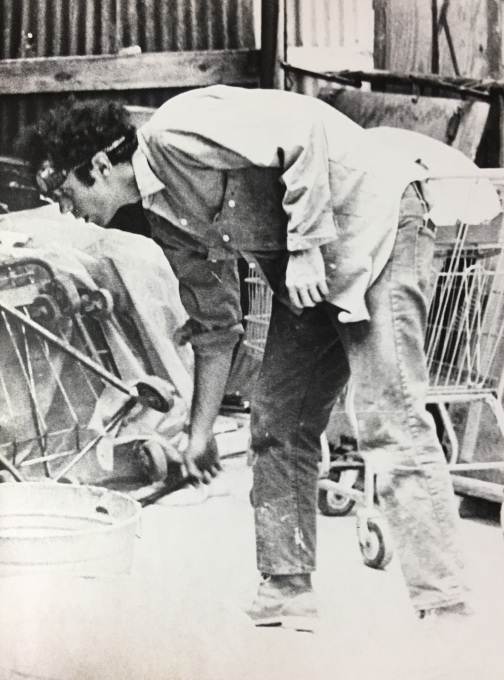
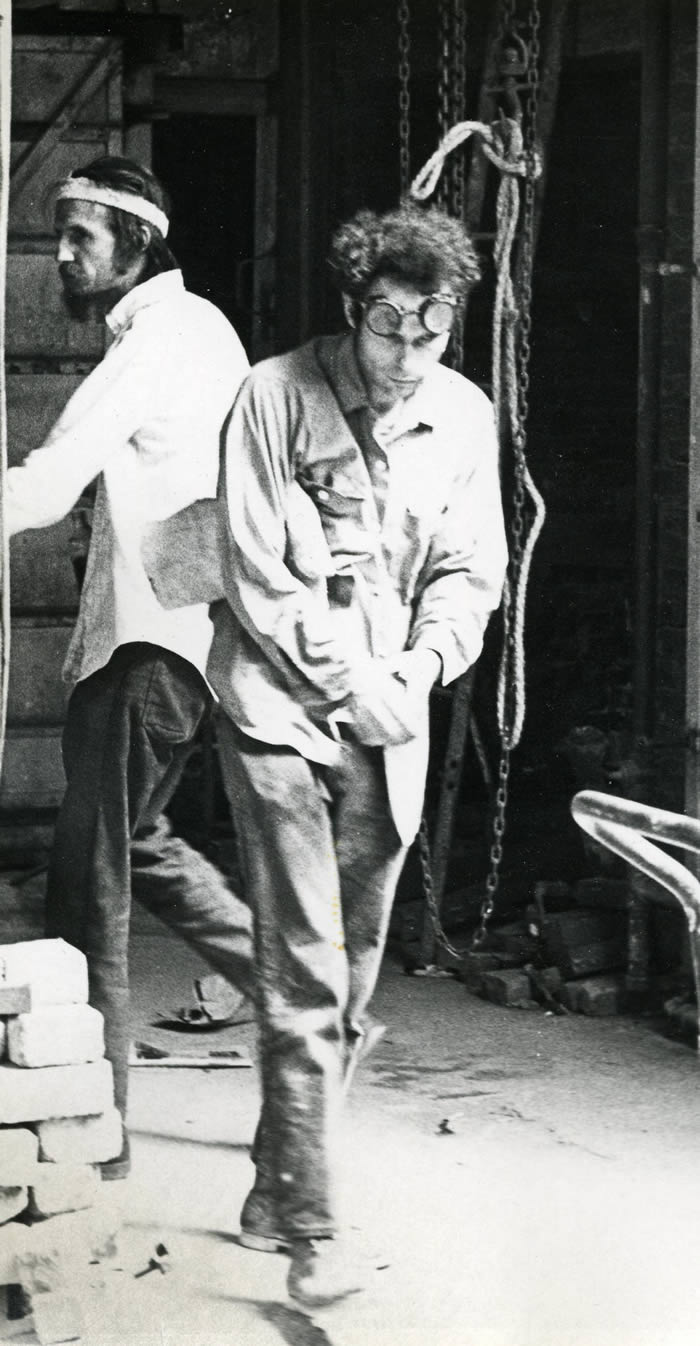
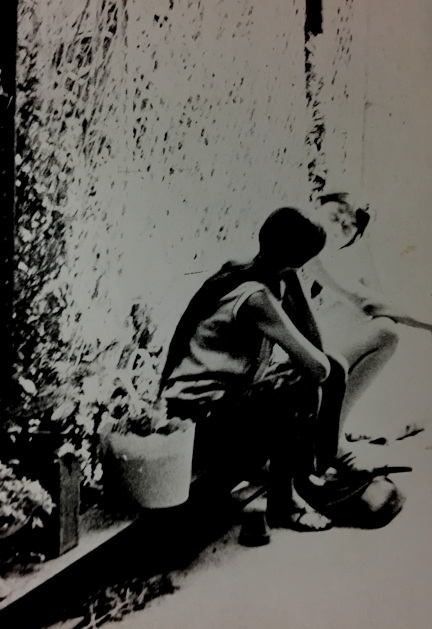
As Mike worked long hours to finish up bronzes for his thesis show, he realized he did not have the time to make the wooden bases he had planned for them, so he asked me if I would help. In exchage, he promised he would do a portrait of Ellen. I was happy to assist, and for nearly a month, I worked on wooden bases and stored many of the works of the thesis show in my shop to give Mike room to work in his. And Mike did Ellen's portrait as promised.

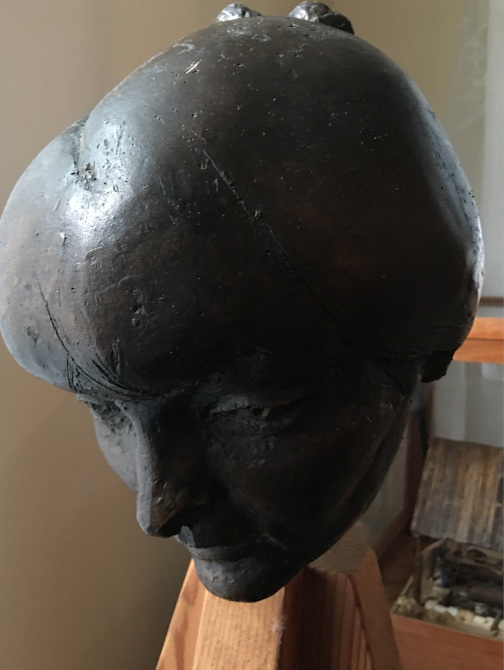
One night, a Tuesday I believe, we were all working late in our studios and got hungry. We wanted to go out for something to eat, but it was 2 AM. Mike said he knew of good place that was open and we ended up driving down to the French Quarter to eat. As we sat in the restaurant, I had the eerie feeling that I knew all the people working at the place, or had at least seen them before. Shortly afterward, I found that Mike was friends with all of them and they had been models for his bronze portraits. I had been surrounded by these portraits in my workshop while making wooden bases for them, so of course I had seen them before.
Ellen and I also were quite impressed that you could go out to eat at a restaurant at 2 AM on a Tuesday. Quite a change from our experiences in Philadelphia.
Some years later, Mike at Hamline, introduced us to Dale Schwichtenberg, then a student there, who wanted to study Macrame and other fiber arts. Mike suggested he contact us and Dale spent some time with us and later returned for an extended stay. Dale had been working as a studio assistant to Mauricio Lasansky and Dale introduced us to the work of Mauricio and his family. Mauricio's son Leonardo was an art professor at Hamline, working with Mike at that time.
While we were writing the first book, living in New Orleans, we met many other people in town active in the arts. Through Larry Songy, we met John T. Scott, a professor of art at Xavier University. John was an amazing artist with wide- ranging interests and abilities. When we knew him, he was working in printmaking, doing lithographs, woodcuts, and collagraphs. We spent many hours sitting around the dining room table at our little house talking about grand plans for an artist collaborative in New Orleans. John even told us about his plans for a musical sculpture entry into a contest to fund a sculpture at the base of Canal Street along the planned Riverwalk/Moonwalk.
You can see his musical sculpture today when you visit the Moonwalk.
John stayed at Xavier his entire career, despite many opportunities to move on, and gave back to his community by training generations of artists. John evacuated to Houston during the post-Katrina flooding, which destroyed his studio. John never made it back home, dying a year or so later after a second lung transplant for his advanced pulmonary fibrotic disease. His work lives on, in museums, private collections, and in curated shows from time to time. We have two of his prints.
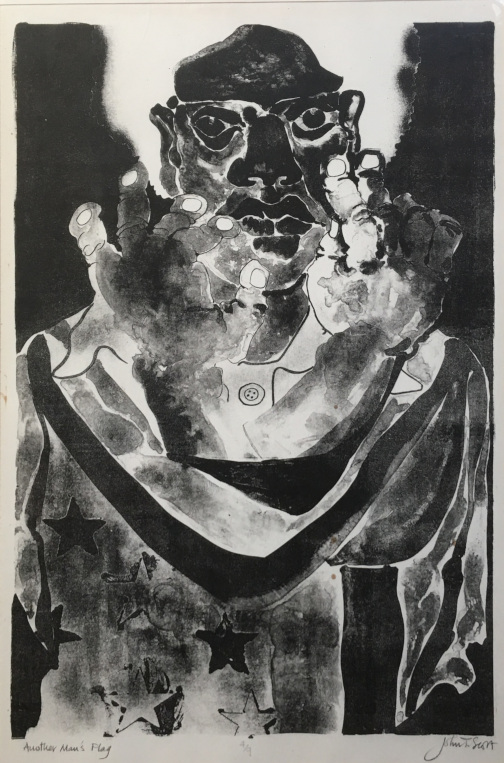
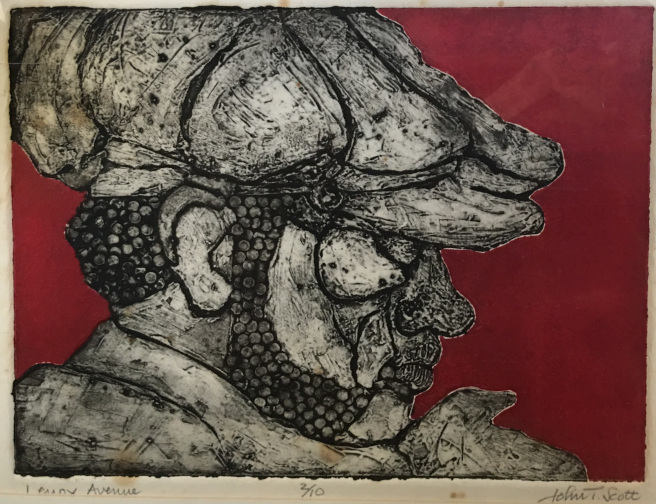
New Orleans is, of course, a photographer's paradise. From the architecture - including the ironwork and cemetaries - to the gentile decadence created by the sub tropical climate, lush vegetation, and accompanying unique life style and attitude, she provides even the casual visitor with a seductive glimpse of a different way to live. And, at the same time, New Orleanians daily live with history, from the stories, myths, and fables of past adventures and adventurers, to the cultural traditions encountered daily, and the inevitable "ain't dere no more" descriptions in locals' conversations.
The story of our first stay there would be incomplete without some additional photographs. Here are a few of one of our favorite St.Charles Mansions. It is near the intersection of State Street, and I passed it daily on my drive to work at the hospital, located at State and Tchopitoulas.
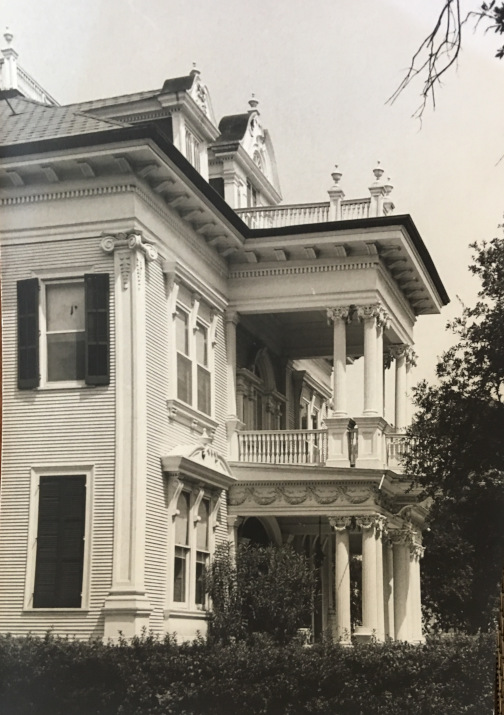
>

There are, of course, hundreds of other photo-worthy houses on "the Avenue" and throughout the city. There are some more in the next page about New Orleans, but you really ought to come see for yourself.
Any selection of photos, no matter how brief, would be incomplete without some cemetery photos. Here are some taken in Lafayette #1, the cemetery across Washington Avenue from Commander's Palace, about 1968. At that time, the cemetery was pretty much neglected, and, as the one photo shows, some of the vaults/tombs were open and vandalized. The last picture in this series shows one of the vaults in the outer wall, open, with the remnants of the last resident visible.

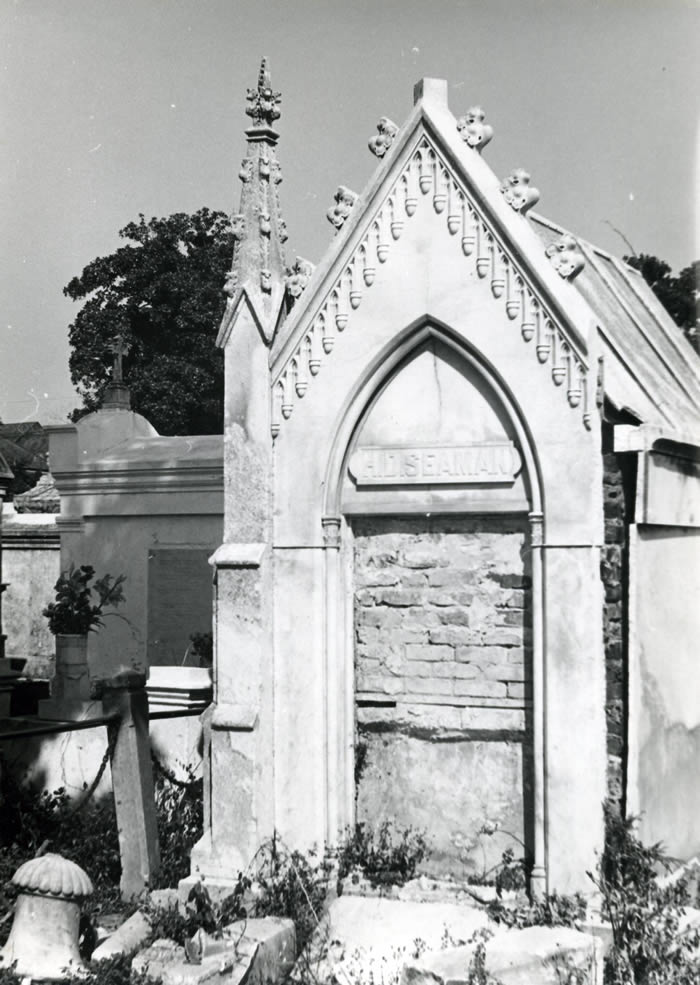
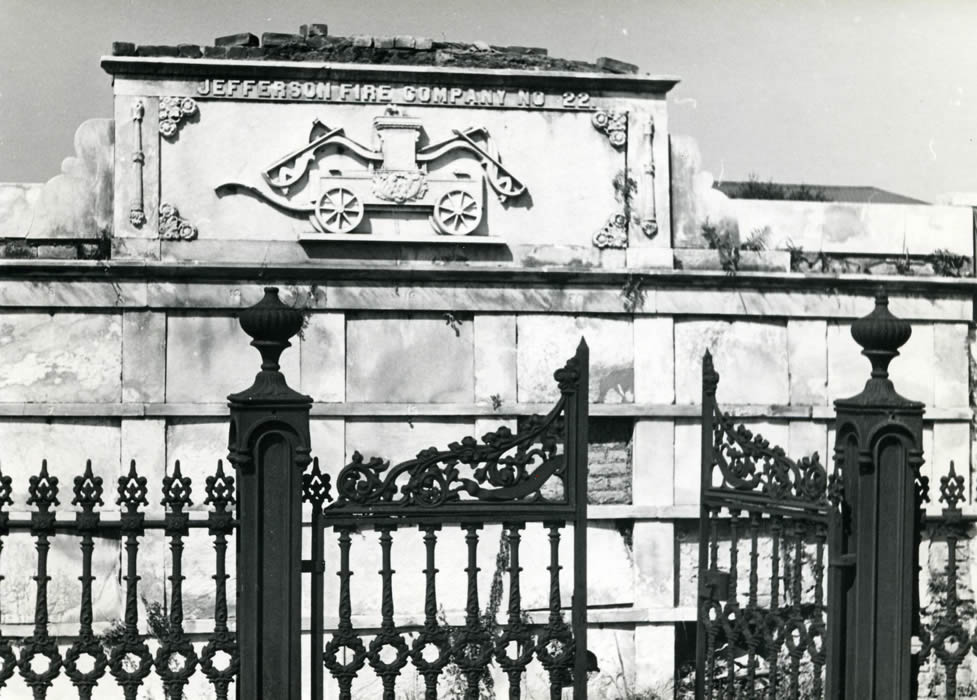
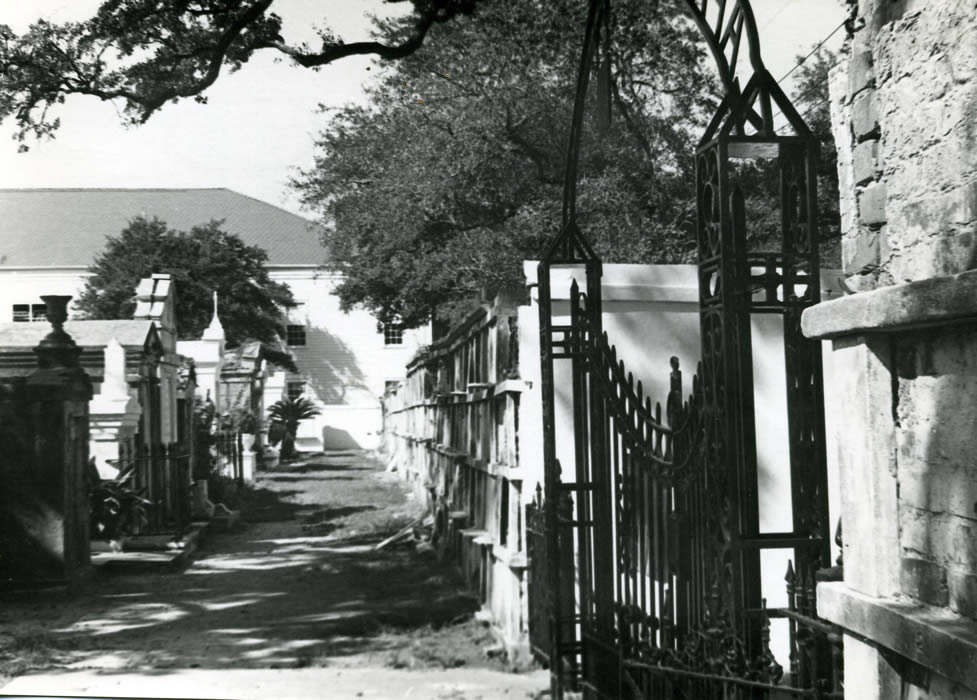
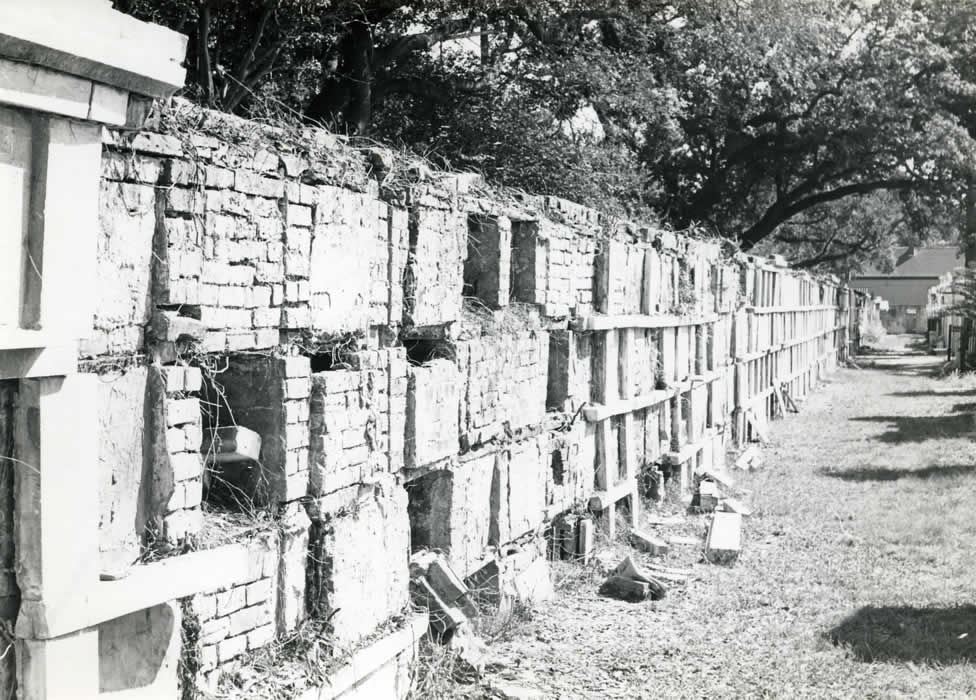
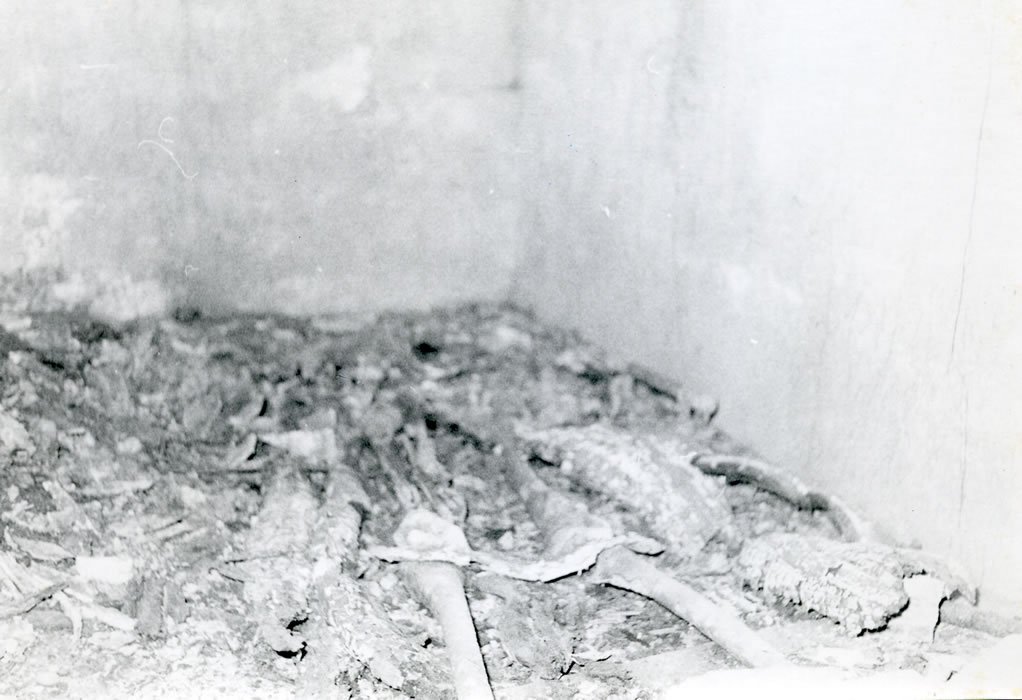
There are plenty of cemeteries in New Orleans, with Lafayette #1, and St. Louis #2 and #3 being the most commonly visited by tourists. But there are others, less frequented by outside visitors, which are just as interesting. Lafayette #2 is further up Washington Avenue, in an area near former housing projects in an predominantly African American neighborhood. St. Lous #3 is up Esplanade Avenue, near City Park/Bayou St. John. And, perhaps more interesting and accessible to us, Carrollton Cemetery, is uptown, just next to the house we used as our studio. At the time we first saw it, the cemetery was somewhat neglected. There was still a "white" section and a "colored" section. The graves in the colored section were simple, just burial plots with markers, often of wood. A cautionary sign prominantly displayed advised those who used the section that "Graves must be kept clean or they will be reused."
The Carrollton cemetery was established about 1849 on the former McCarty Plantation, which was becoming the town of Carrollton at that time. The plantation benefitted from heavy alleuvial deposits of soil during the frequent flooding of the river and thus had some higher ground permitting burials in ground, unlike lower areas, where tombs had to be above ground due to the high water table. The cemetery is bounded by Adams, Birch, Hickory, and Lowerline Streets. The down-river edge of the cemetery is "Lowerline Street", the former boundary of the plantation and later of the town of Carrollton. In New Orleans, directions are given in reference to the river and the lake: toward the river or toward the lake; upriver = uptown or downriver = downtown. A corner might be described as "the downtown riverside corner", for example. Our little studio was on the "lake side of birch, near the uptown corner with Adams".
New Orleans has many odd street names and peculiarities. So although the fact that Lowerline Street is "above" (upriver} from Upperline Street is confusing, but understandable because Upperline was named before the city annexed Carrollton and Lowerline only became a New Orleans street at the time of annexation.

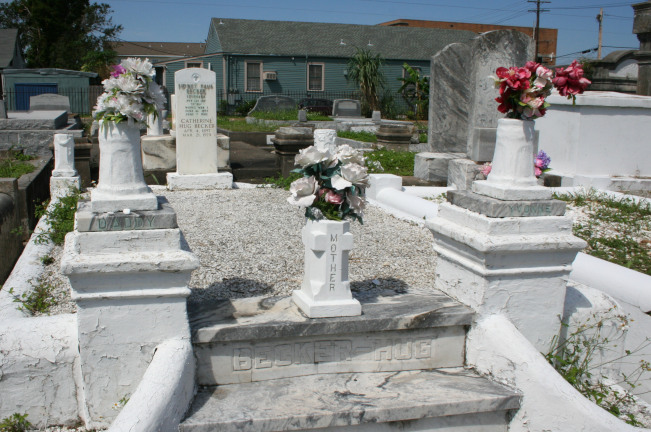
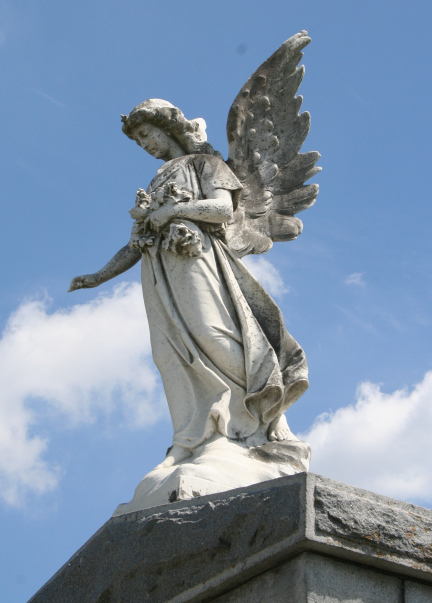
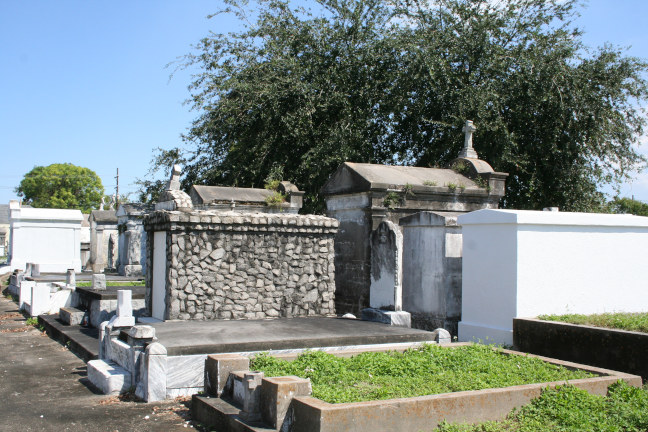

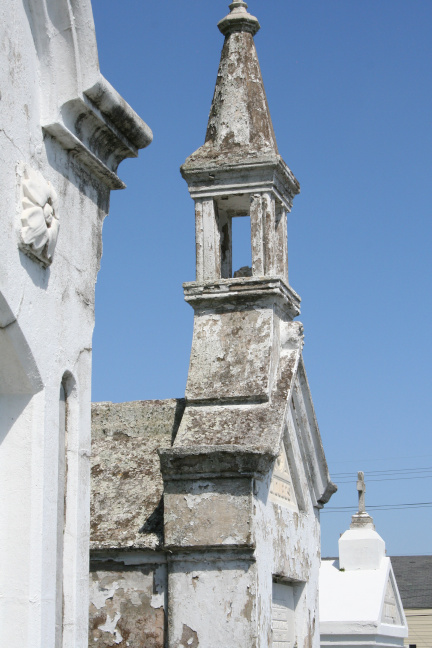


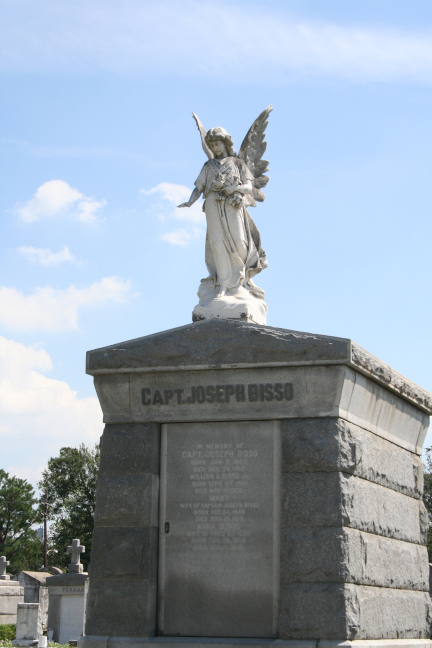
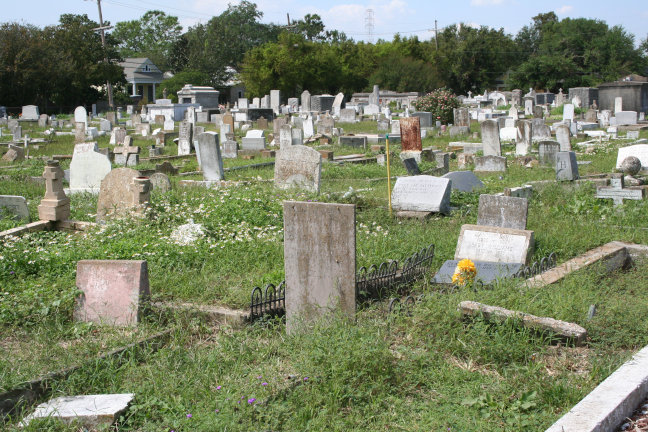
Another photographic tour we took was a visit to Fort Macomb. Macomb was one of two forts built in the 1820s largely in response to the British attempt to invade New Orleans from the southern approach at the end of the War of 1812. The British had a large naval force and troop transports in the Gulf of Mexico but were prevented from entering Lake Borgne, then Lake Pontchartrain, by a small flotilla of American gunboats, so they landed the troops south of the city and moved to the east bank of the Missisppi, where they were met by American troops under Andrew Jackson and defeated. Subsequently, it was decided to better defend the sea approaches from the Gulf with two forts. One, Fort Pike, was constructed to defend "the Rigolets", the more northern pass from the Gulf to Lake Borgne, the other, Fort Wood, later Macomb, protected the Chef Menteur Pass, the other way to Lake Borne. Since Lake Borgne connects directly with Lake Pontchartrain, which is the northern edge of the city, this constitued a vulnerability in the defence of New Orleans.
Fort Macomb is an earthen filled brick-walled structure. It has vertical walls which house interior large gun emplacements and form a pie-wedge shape with the curved wall facing the water and the two intersecting straight walls facing land, and separated from the land by two moats along the straight walls. Inside the walls was a courtyard and a two-story central citadel with room for storage and housing, also equipped with gun ports. The two forts were pretty much obsolete at the time they were constucted, as the development of shell guns firing explosive projectiles had rendered vertical brick walls nearly useless in defending against bombardment. Fortunately, neither fort was ever tested in combat, although both were briefly occupied by Confederate forces in 1861 before New Orleans was taken by United States forces in 1862. Both forts were abandoned by the Army about 1890, and sometime later were given to the State of Louisiana. Both are within the city limits of New Orleans.
At the time we visited Macomb, it was abandoned and neglected, mostly used for target practice by local hunters. Subsequently, it suffered further decay and neglect and in the latter 20th century, was deemed unsafe for visitors, so never developed as a tourist site. The State put available funds into restoring Fort Pike instead. Both forts were badly damaged by the flooding from Hurricane Katrina and several subsequent hurricanes. Fort Pike has been open off and on since Katrina, but is now (2019) closed due to lack of funds.
For those interested, there are numerous photo-essays on Fort Macomb on the internet from later times. These pictures on this page are from 1968/69.
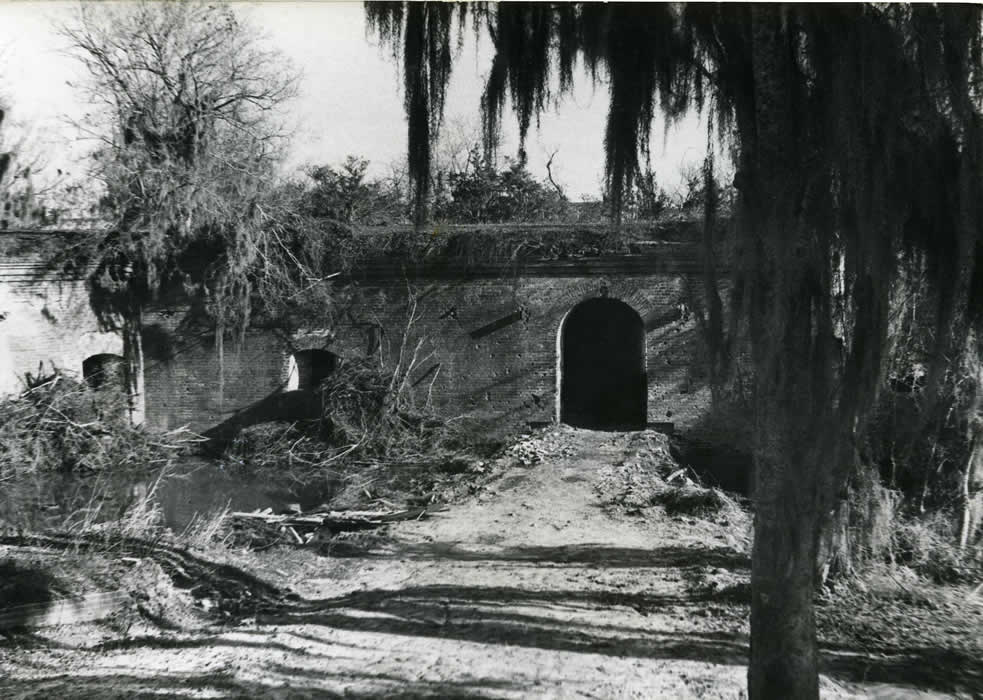
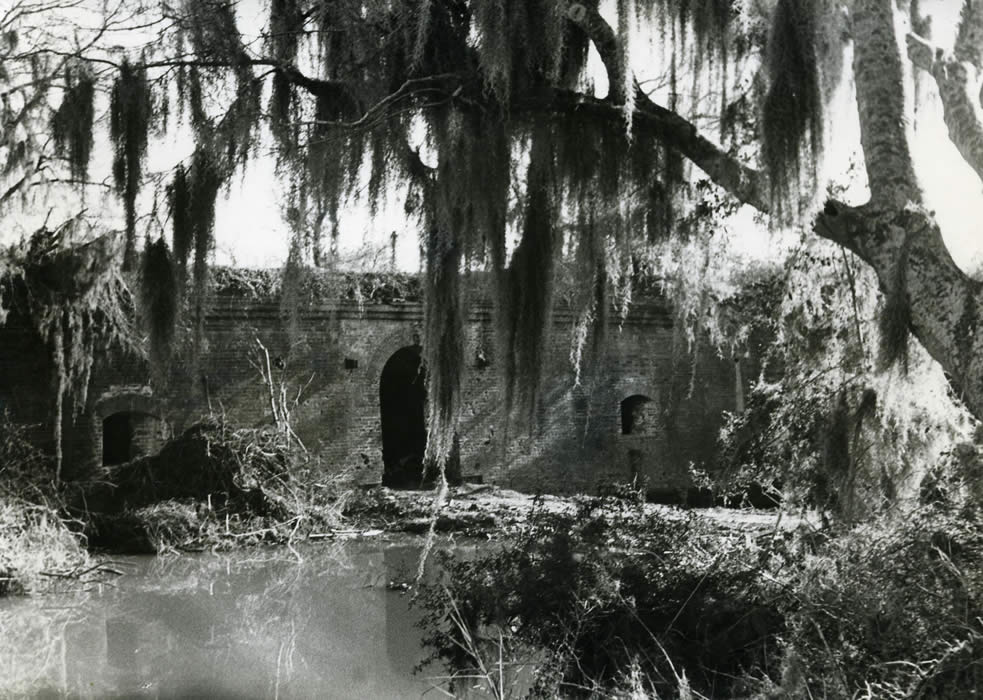
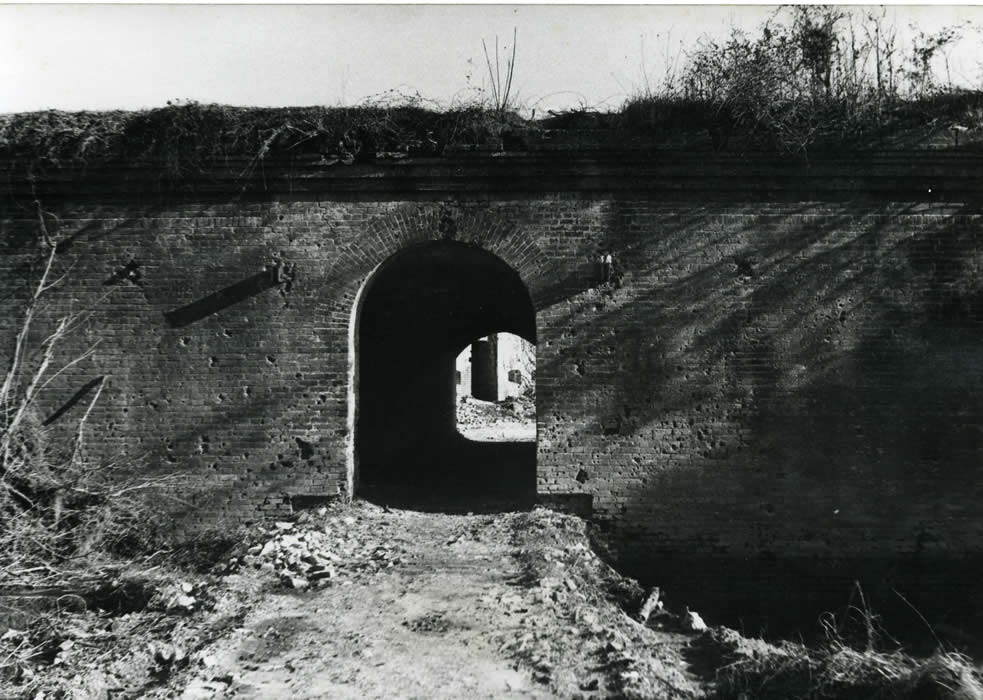
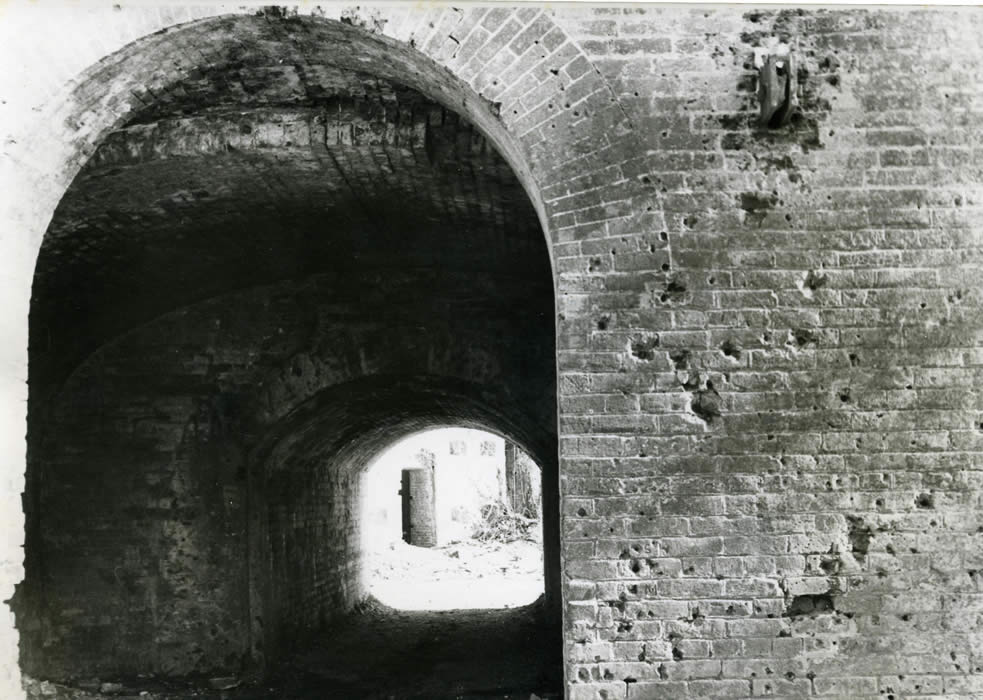
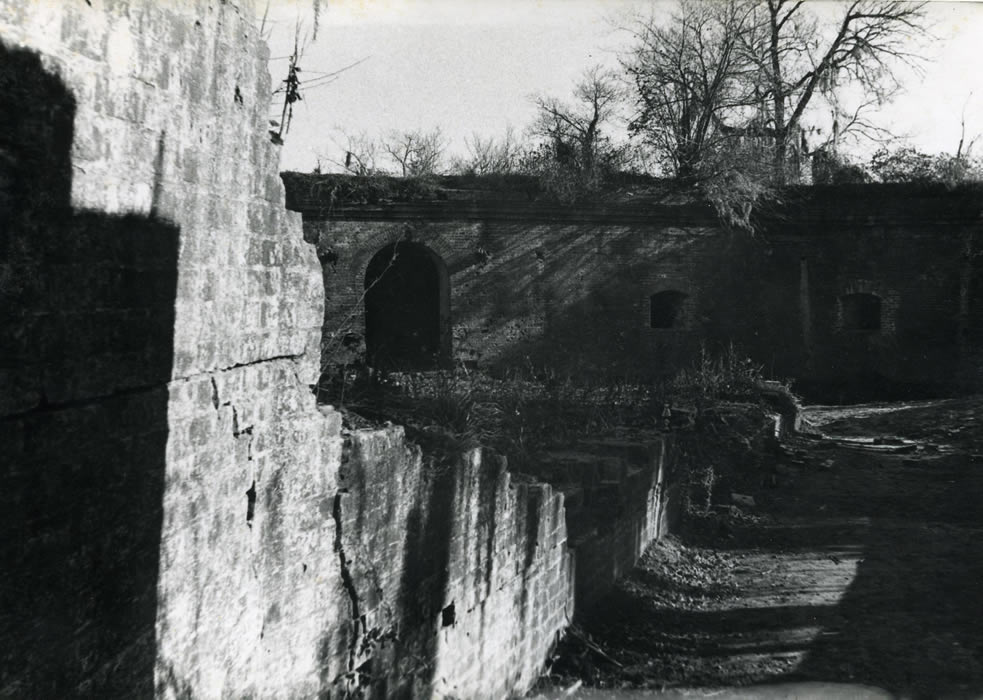
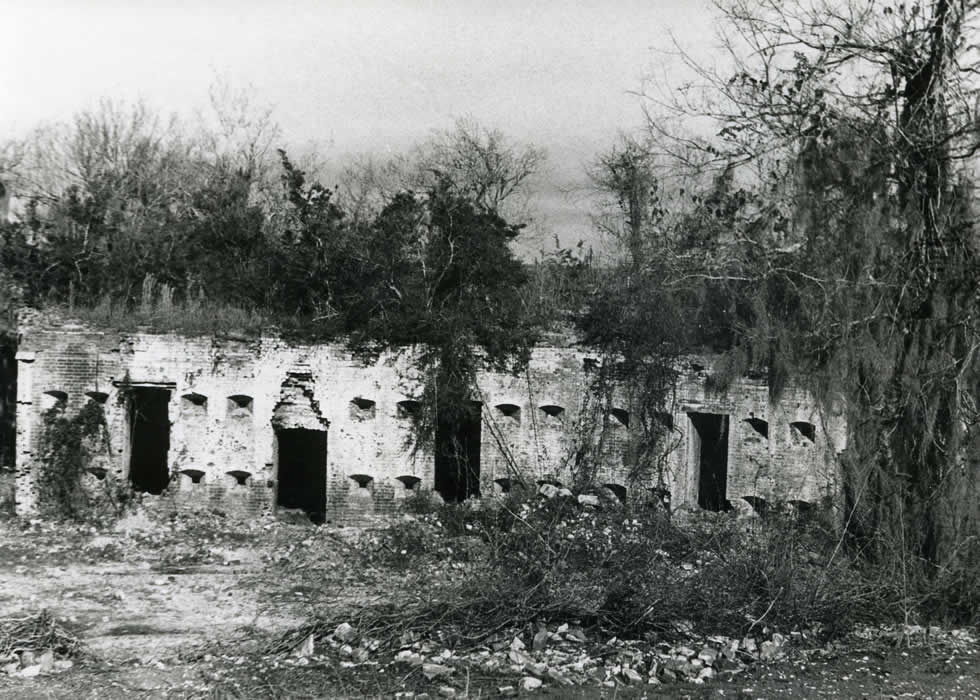
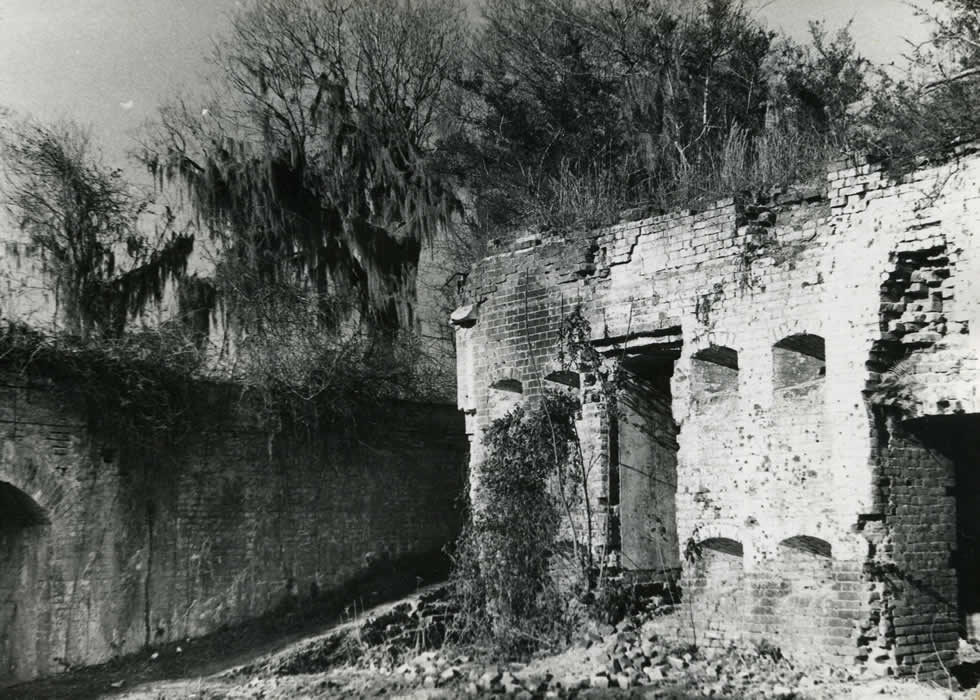


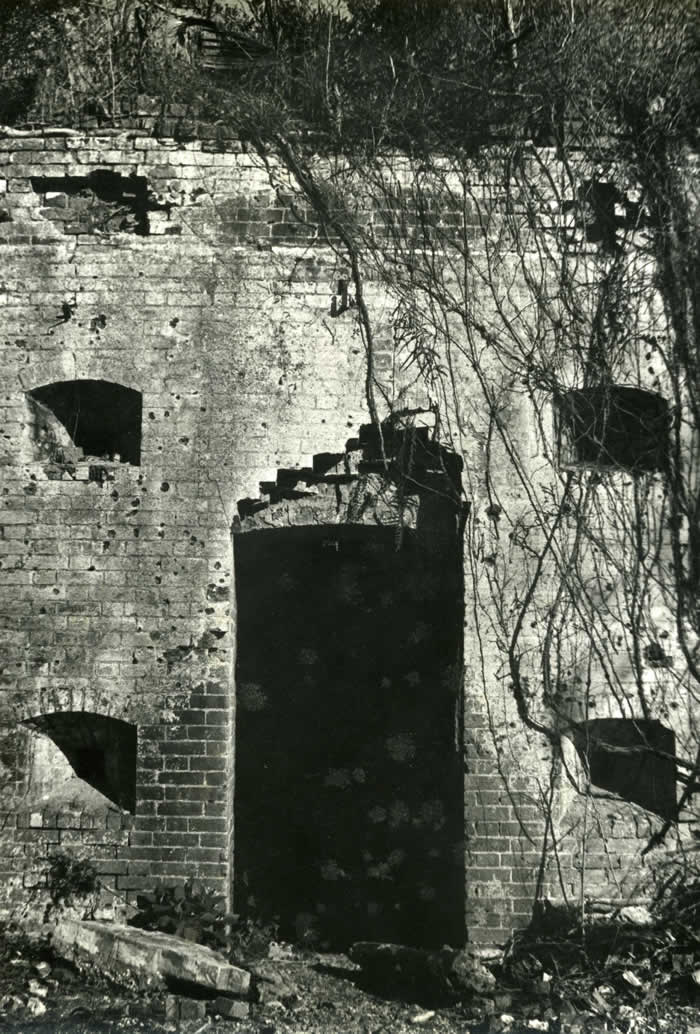
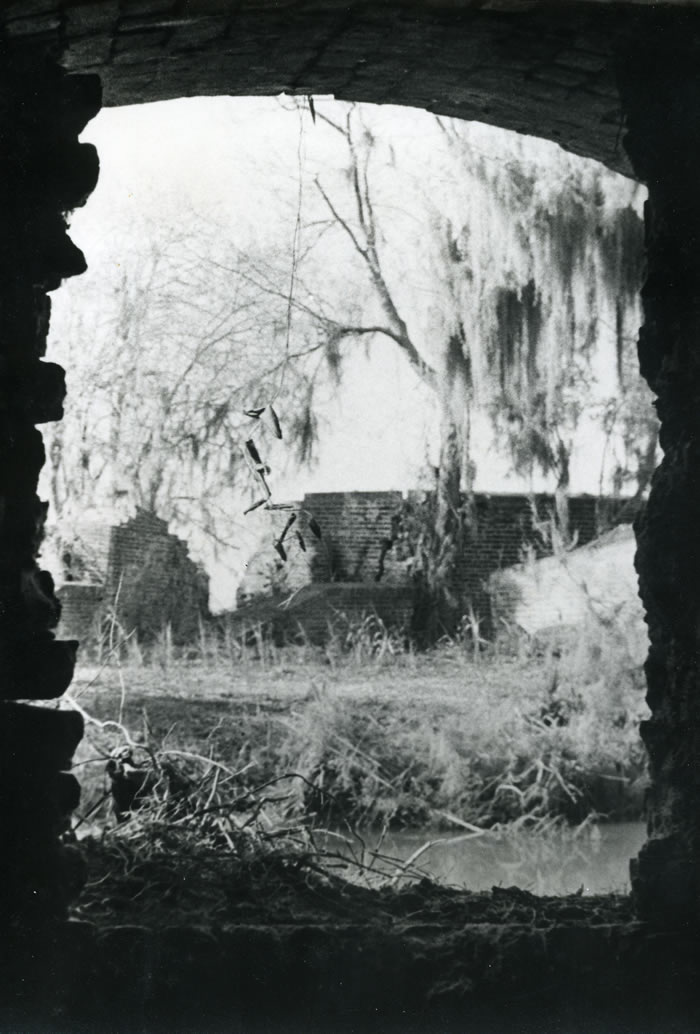
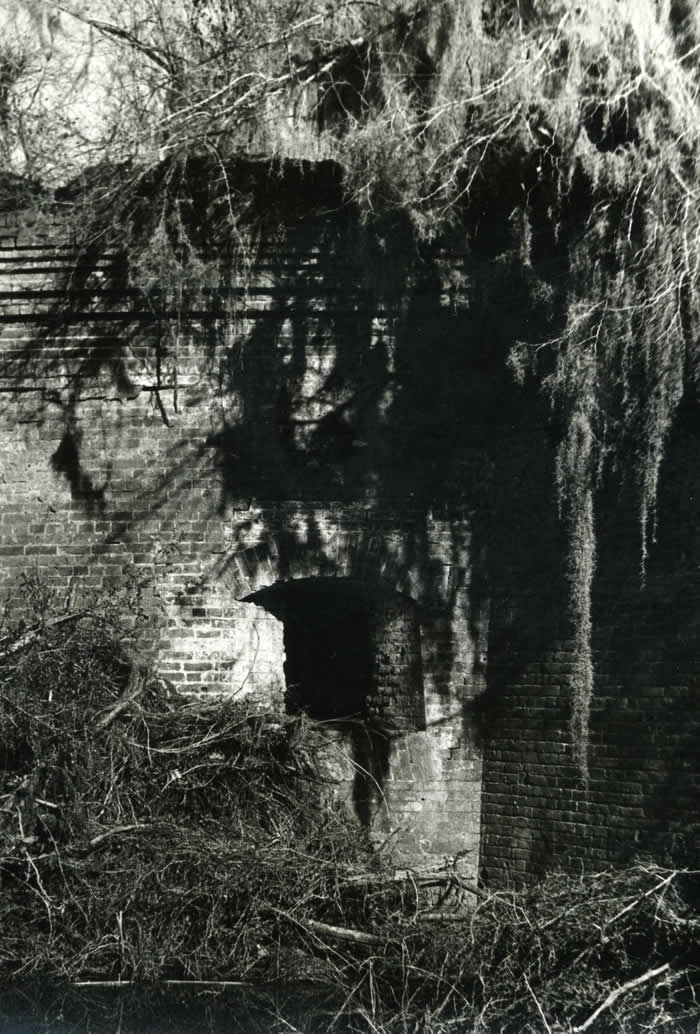

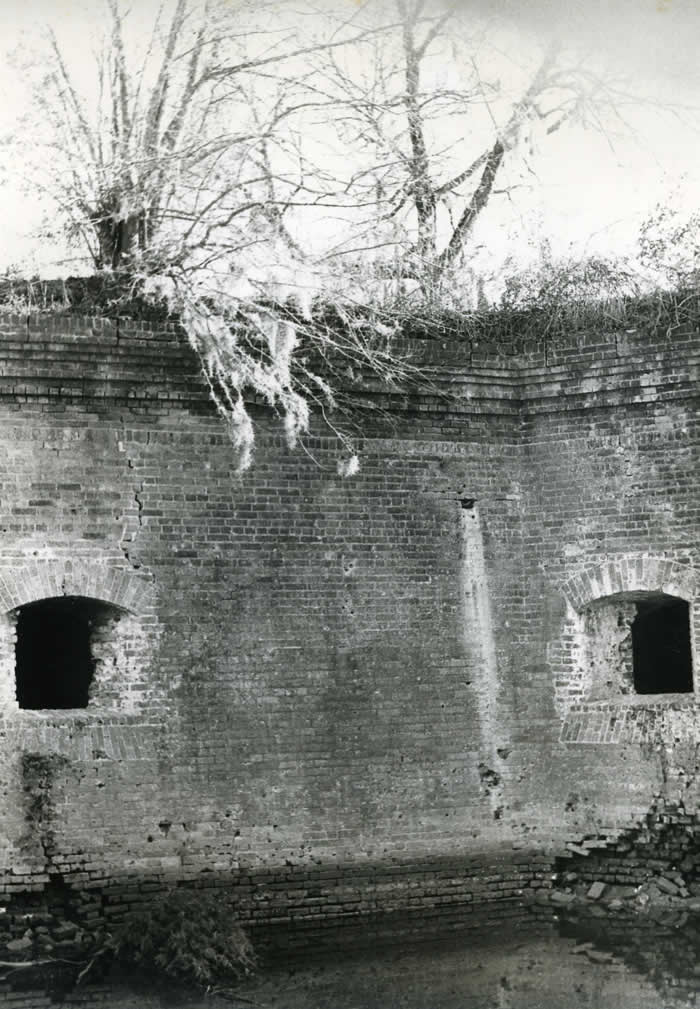
"The Report from Iron Mountain on the Possibility and Desirability of Peace" is a book, published in 1967, which purported to be a leaked copy of the report of a fifteen member special panel of experts convened by the Lyndon Johnson administration to consider and report on the social and economic effects of an immediate peace in the American war on Vietnam. It was intitially published, and categorized by libraries, as non-fiction, but in 1972 a satirist, Leonard Lewin, claimed to be the author and further claimed it was a hoax/satire. He indicated that his publisher had been in on the hoax and had classified it as non-fiction to perpetuate it.
The book, and the working group, took its name from the first location that the group met, a super-secret, nuclear bomb proof, underground U.S. government bunker somewhere in upstate Pennsylvania or New York. The group supposedly subsequently met at secret locations elsewhere in the US and did not return to the original meeting site.
According to the book, the group was made up of politicians, business men, economists, and other experts from both the private and academic setting. The panel allegedly reached the conclusion that war was necessary for the preservation of the government of the United States and for the maintenance of the economy. The basis of this conclusion was that the economic system of the United States required the continuing production of goods but that the market demand did not support this long term, so some means to destroy what was being produced was needed to ensure continuing demand. Further, the nation's means of production did not require sufficient numbers of workers to maintain employment at an acceptable level. A sudden peace, with resulting return of former service people to the workforce, coupled with the end of the recurring expenses for military supplies and equipment, would produce a shock to the U.S. economy sufficient to cause a major economic depression.
The book was published near the peak of anti-war sentiment in the country, and became popular with anti-war activists and well as those with anti-corporation and anti-capitalist sentiment. It was on the New York Times Best Seller list. But most readers, ourselves included, thought it was fiction.
Until, that is, we met Tim Tupper, a VISTA volunteer working in New Orleans in 1968-70. The VISTA program ("Volunteers In Service To America") was a sort of domestic Peace Corps, in which young people would work in poor or underserved areas of the U.S. essentially for a subsistance allowance. We, along with several friends who were active in social programs in New Orleans, got to know the VISTA volunteers working in town, and fed them when we had a chance and otherwise tried to assist them. One evening, in conversation with Tim, he related how he had worked a summer job at Iron Mountain. According to Tim, the facility was an underground, nuclear-bomb-proof, secret U. S. government facility which had been completed by the time he was working there. His job was to wheel-barrow concrete into the lateral shafts leading into the facility to seal them. He also talked about the security there. He, and the others who were sealing the tunnels has very limited access to the facility, and we only to walk on designated pathways to and from the job site and within the job site. On one occasion, he walked off the path, and an armed guard appeared from a hiding place in a tree trunk and warned him back to the designated approved path. So, it appeared the Iron Mountain was a real facility. And maybe the book was real, also. It has provided plenty of fuel for the fires of conspiracy theorists.
Years later, I saw the logo of the "Iron Mountain Company", which had purchased a paper mill in New Hampshire near where we lived, and were remodeling it as a secure data and records storage facility. We know one of the contractors working on the site and were very impressed by his descriptions of the security being installed there.
So, the "Iron Mountain" company today operates multiple nuclear proof data centers around the country and the world as well as other records and data storage facilities not underground. According to the history of the company, as they tell it, the entity was founded in 1951 by a former mushroom grower whose business had failed and who decided to open a bomb-proof storage business utilizing a former iron ore mine in upstate New York he had earlier purchased for his mushroom growing. Supposedly he has named the location "Iron Mountain" and that became the name of the company. The company information also includes their purchase of a former U.S.government records storage facility named "Iron Mountain" and located in upstate Pennsylvania.
The history is murky. The book may be fiction. If you are not inclined to accept that the U.S. government built nuclear bomb proof underground facilities, I suggest you research the secret bunker at the "Greenbrier" resort in West Virginia. Built to house all 535 members of congress and their families, it is a 112,500 square foot facility carved out of rock 750 feet underground and hidden by the resort itself. It included housing, meeting halls for both houses of congress, food and supply storage, power generation capacity, decontamination chambers, and a small hospital. It was built in secret from 1958 to 1961; even nearby neighbors were allegedly unaware of the project. Its existence was exposed in a Washington Post article in 1992, and today, you can take tours of it while at the Greenbrier. So maybe Iron Mountain, and the report are real.
When we lived in New Orleans the first time, it was a popular test market for consumer goods. At least weekly, sometimes more often, we would come home from work to find a sample of some product hanging on the door. I don't think we ever had to buy dish detergent or laundry detergent while we lived there.
Sometime around 1969 or so, a dentist somewhere invented a new product, a flavored douche. The idea generated some attention in those early days of sexual liberation, and Revlon, the big cosmetic company, became interested enough in the product to attempt a marketing trial. The product was named "Cupid's Quiver" and labeled as a "scented" feminine hygiene product. It was available in three scents: Raspberry, Champagne, and Jasmine. The packaging was clever, but the product was little more than perfumed soap solution, so likely would not have been particularly useful or tasty. Unfortunately, the marketeers chose New Orleans as the test market. Not surprisingly, it was something of a success in the test. Also not surprisingly, it failed when sold nationally. A lesson, perhaps in the need to choose test markets carefully. New Orleans is today not a test market that we are aware of.
